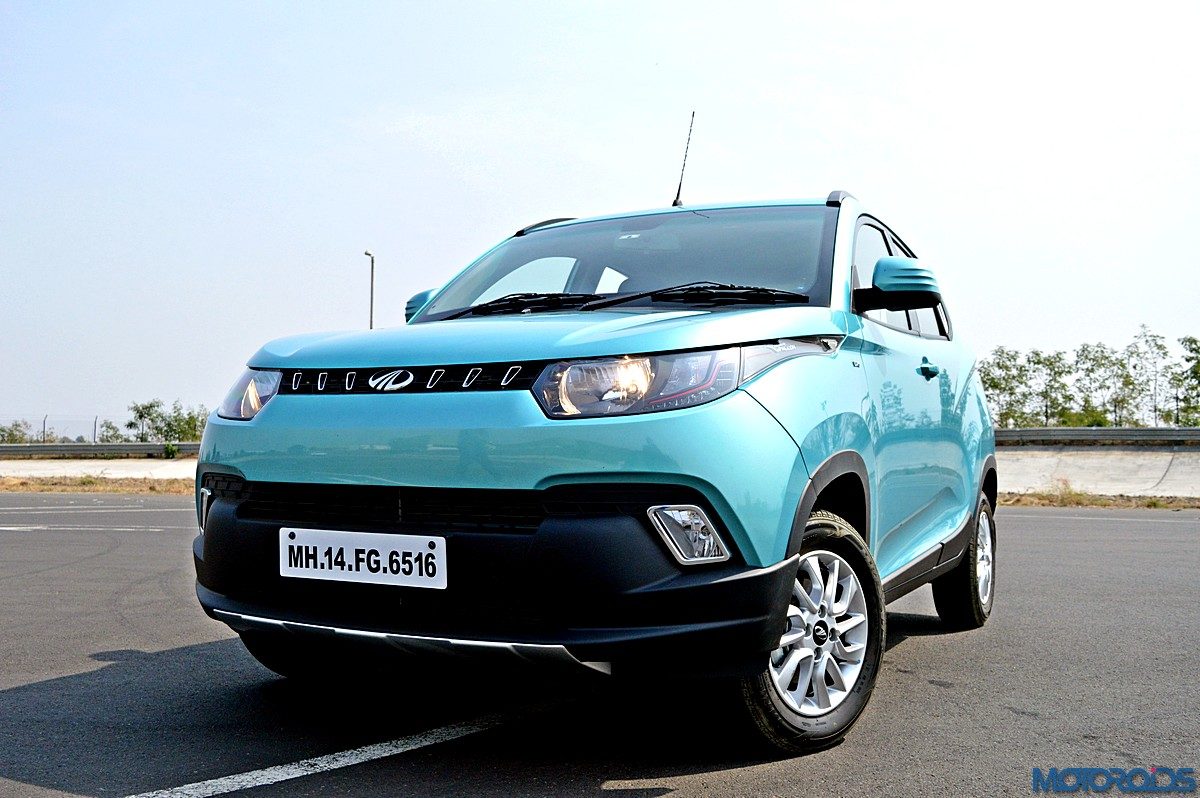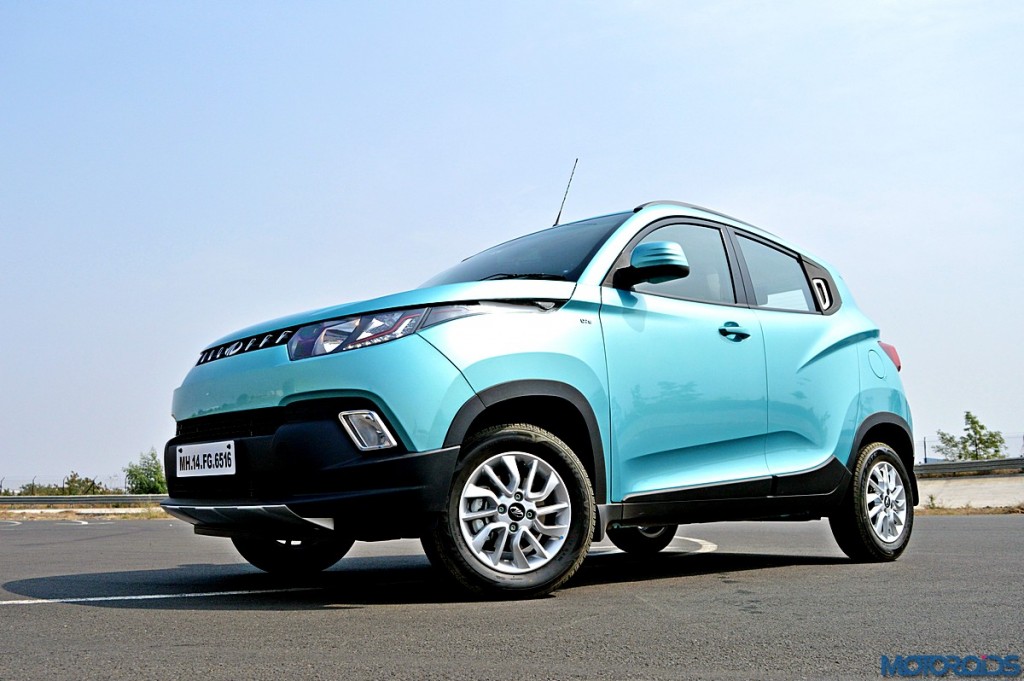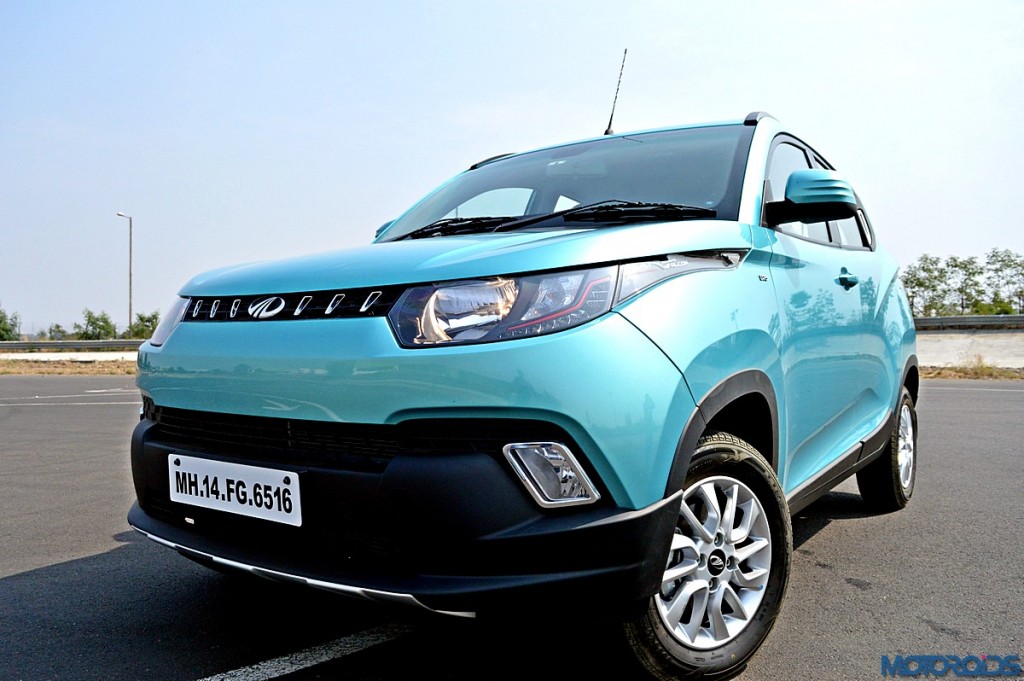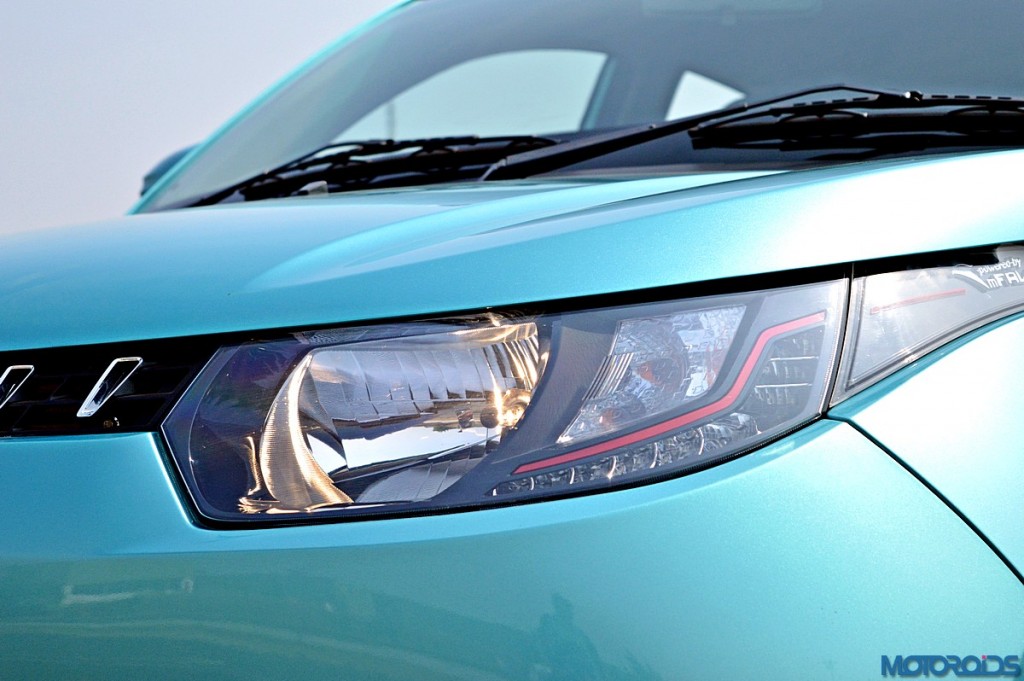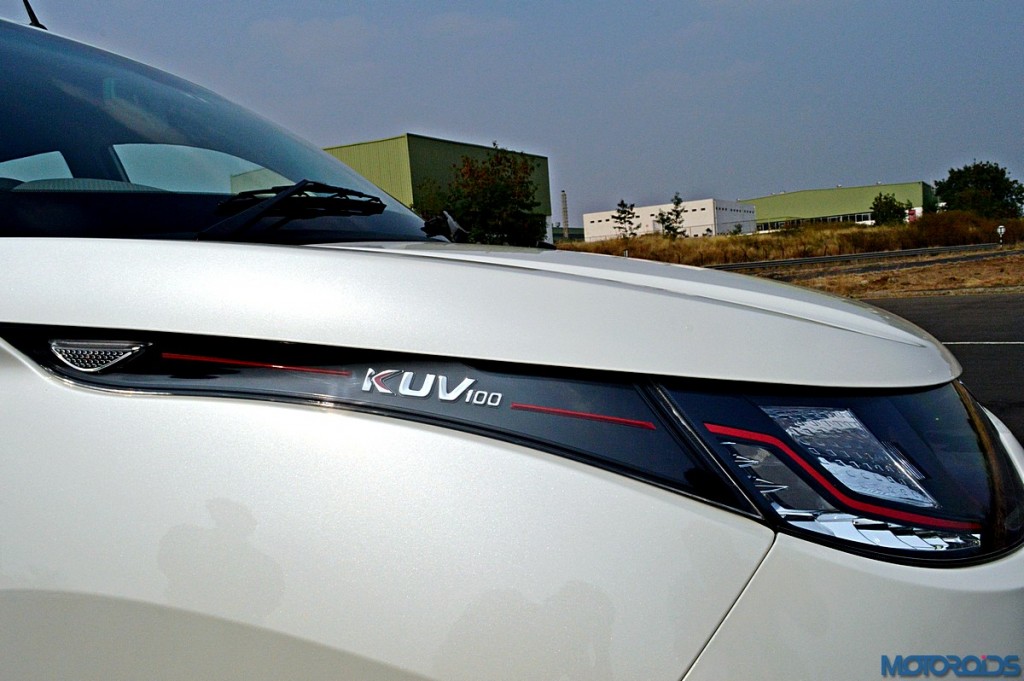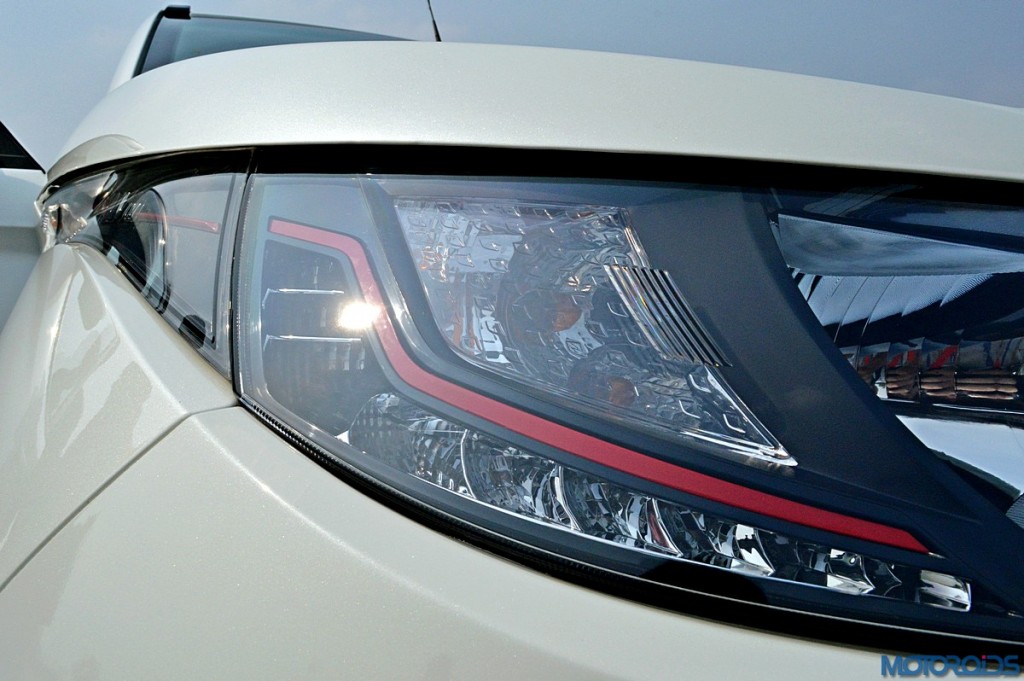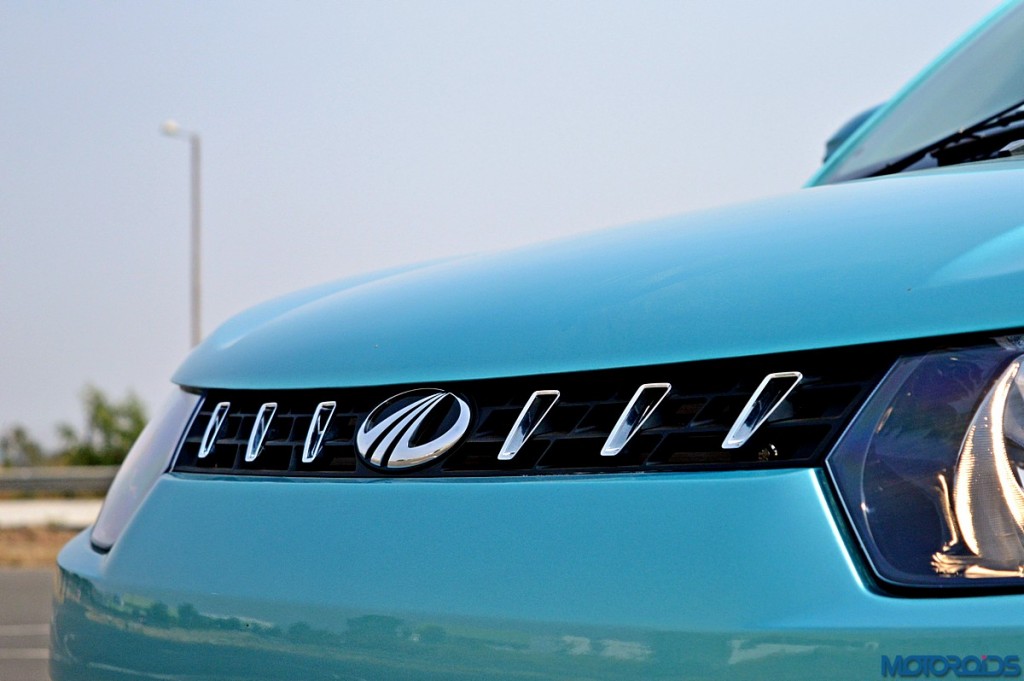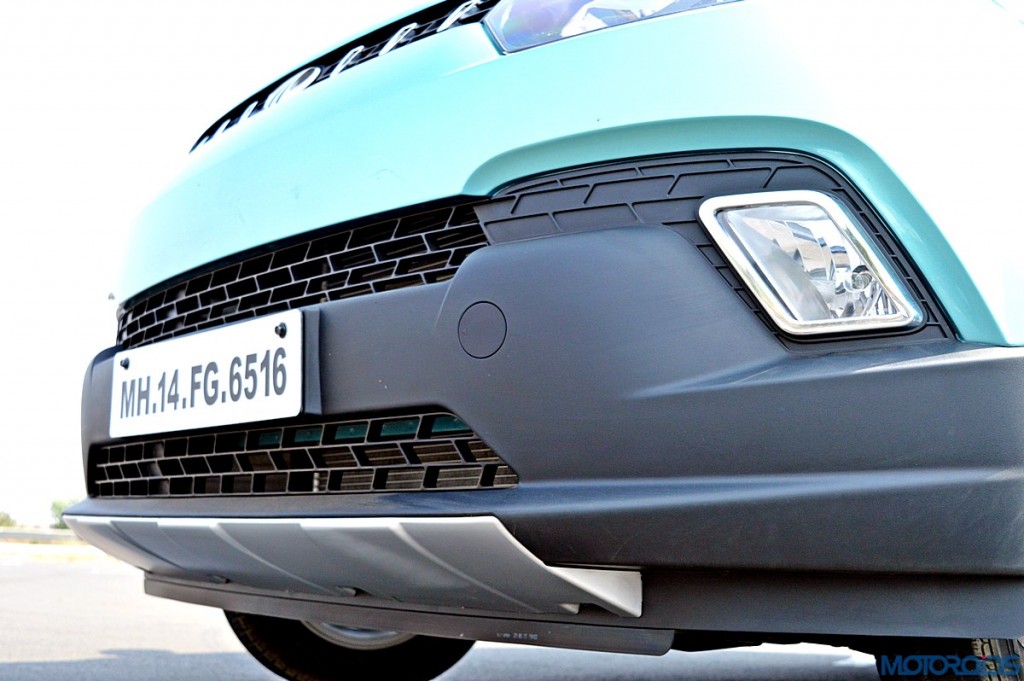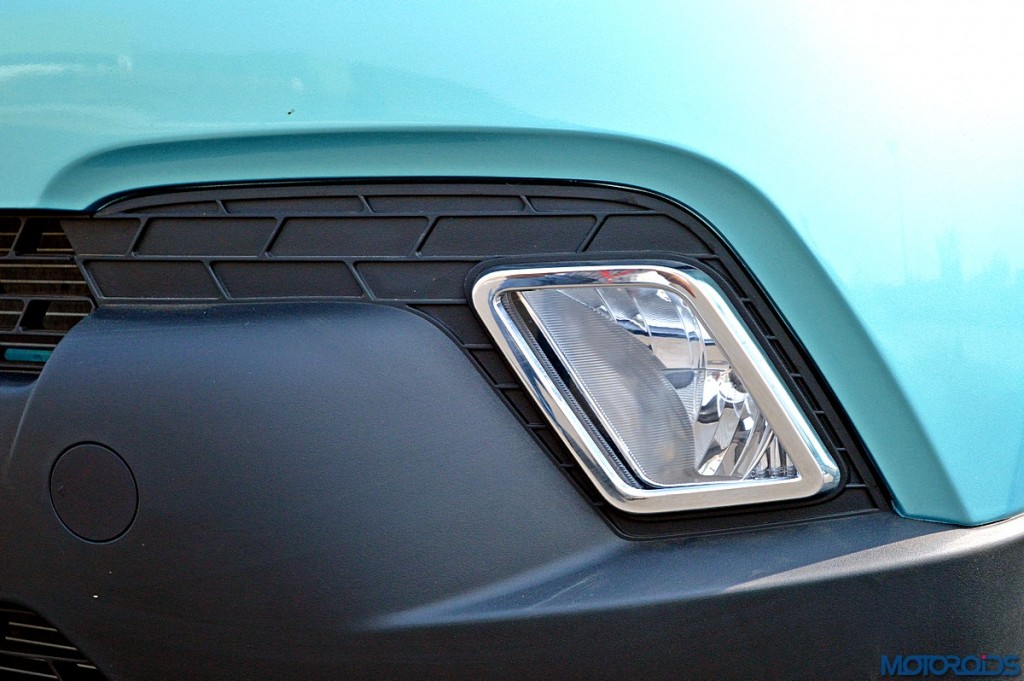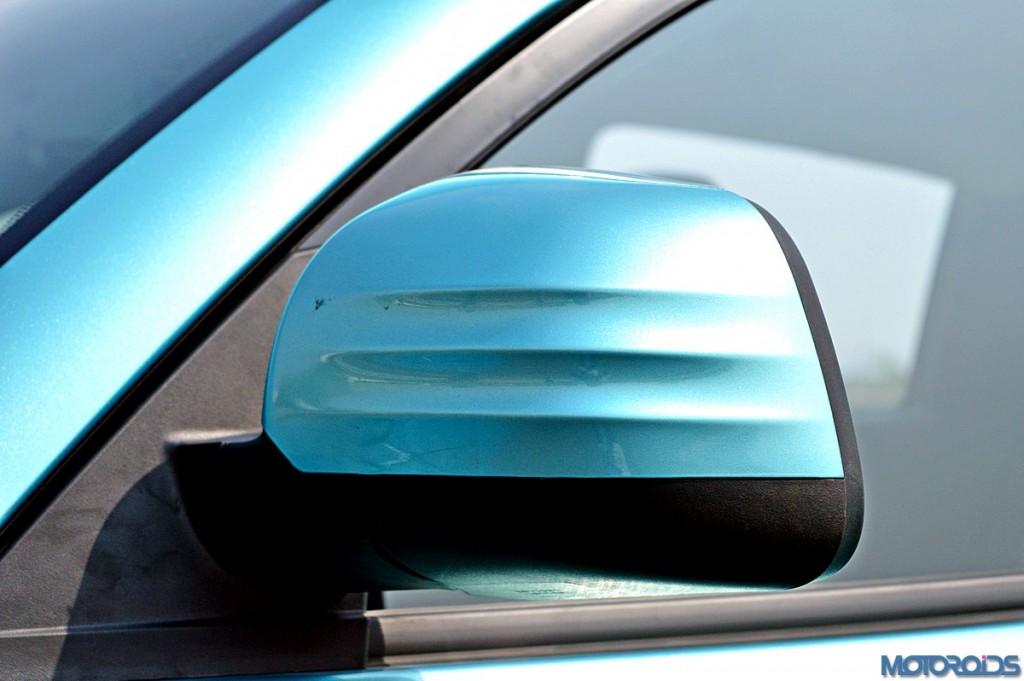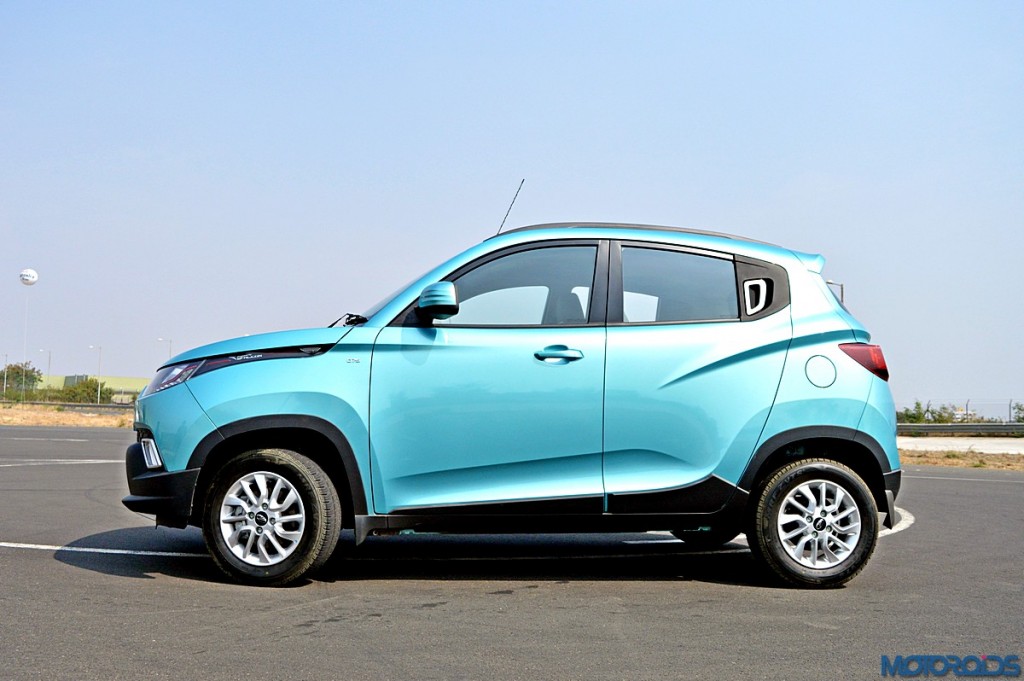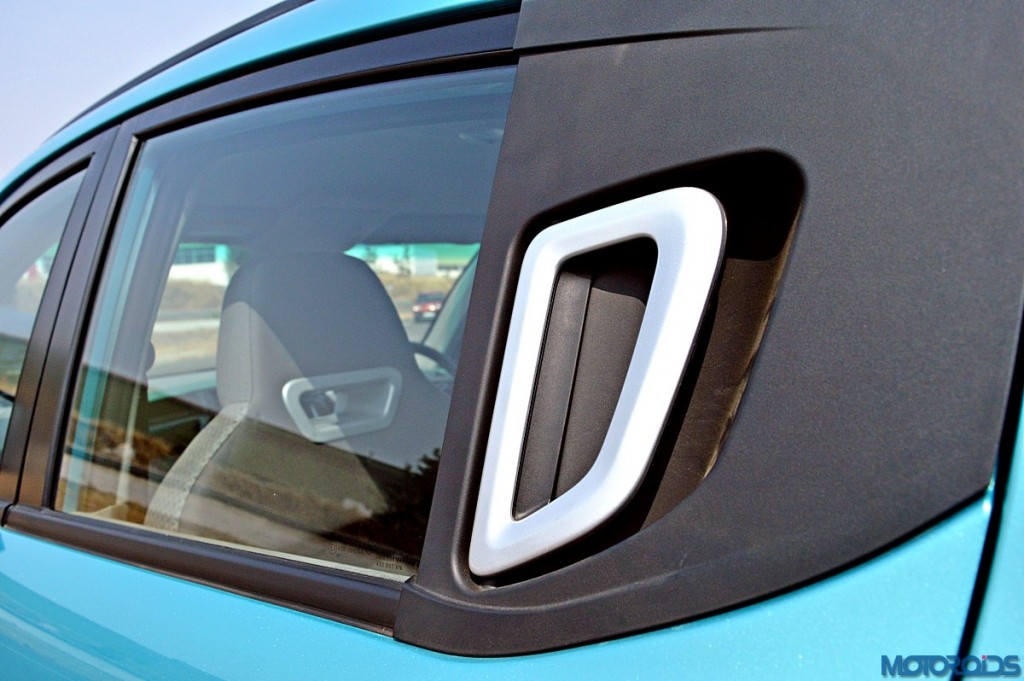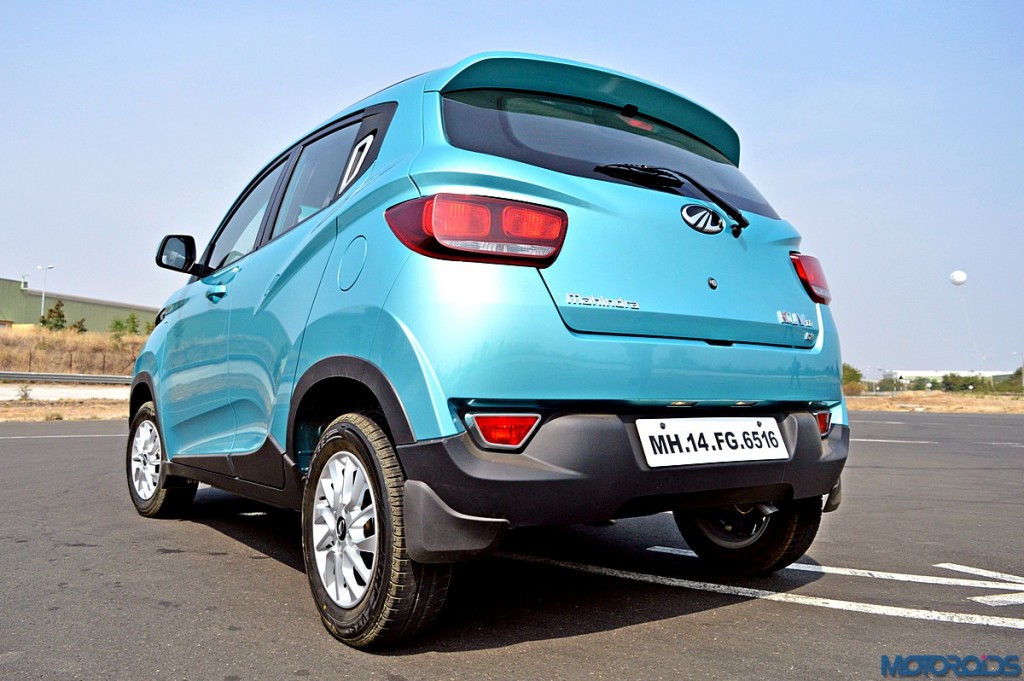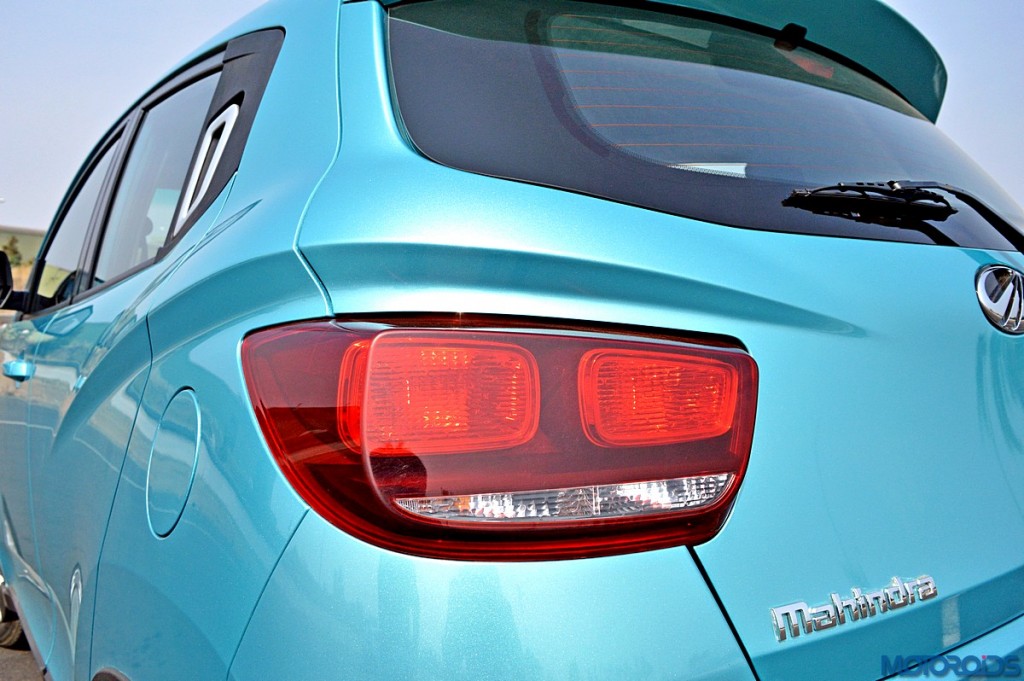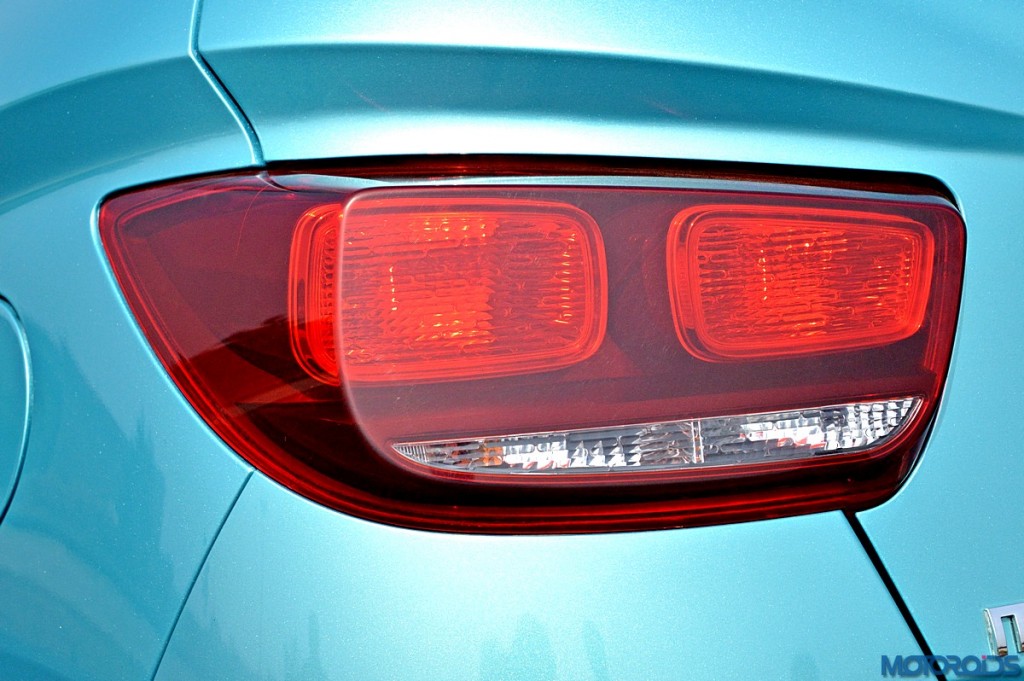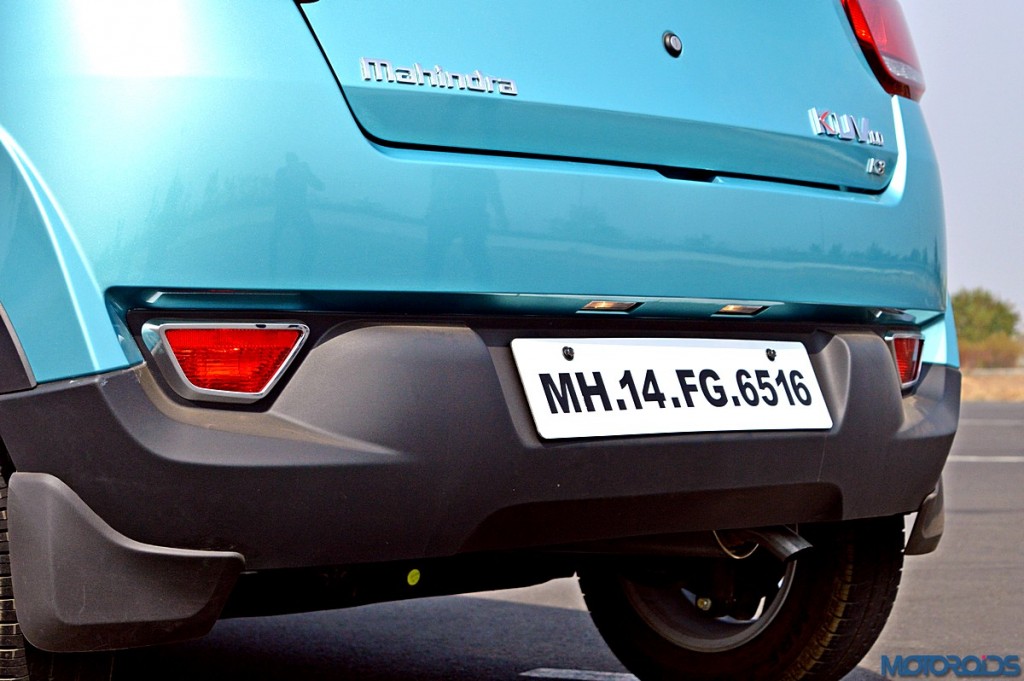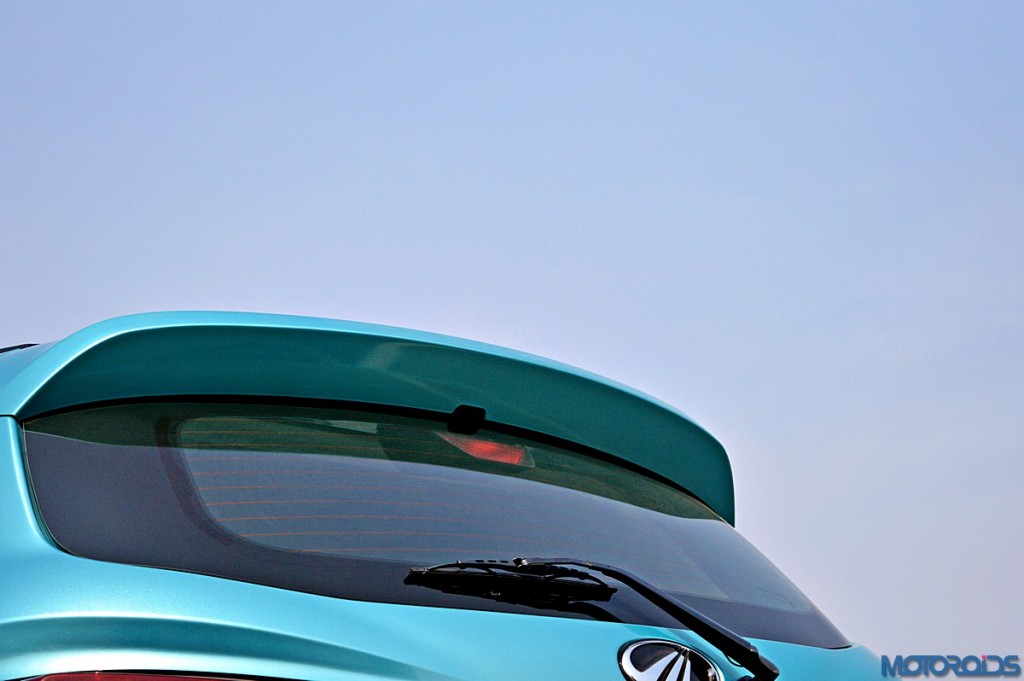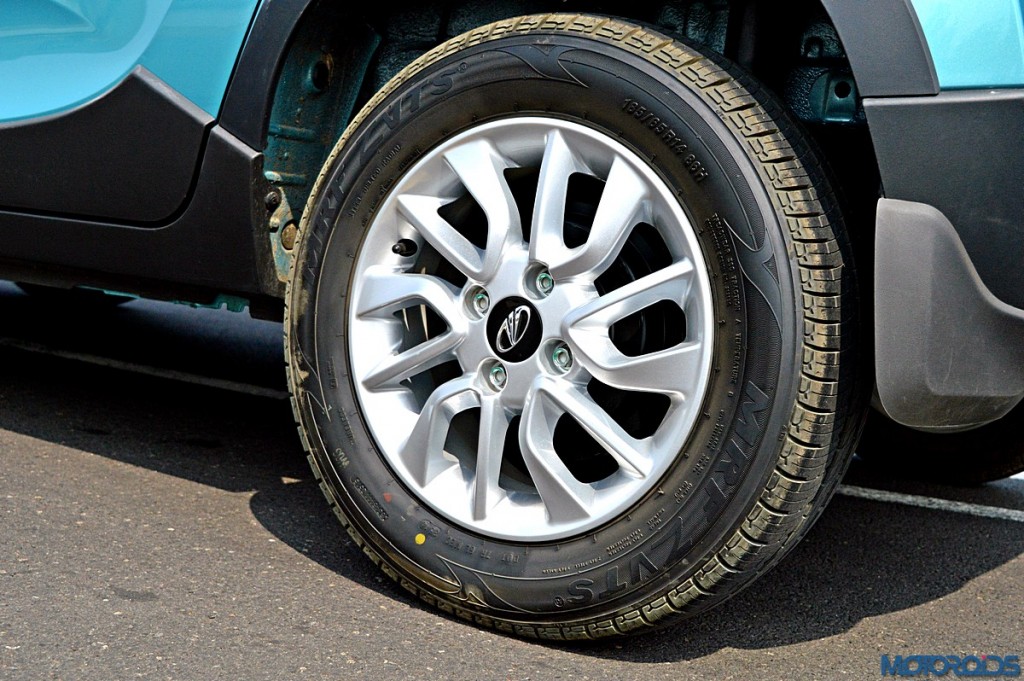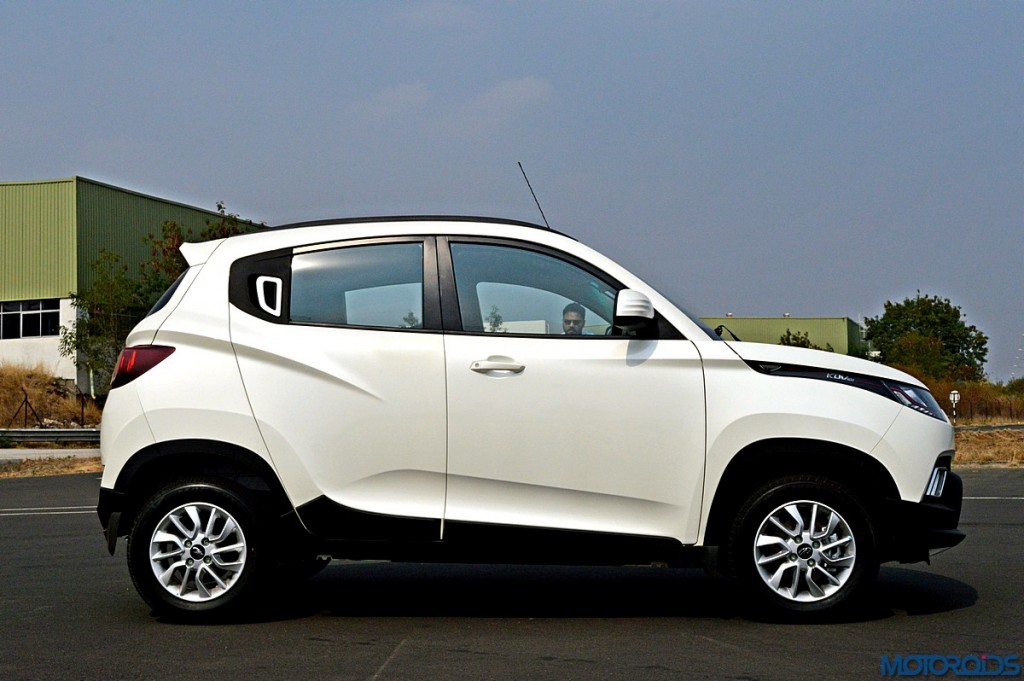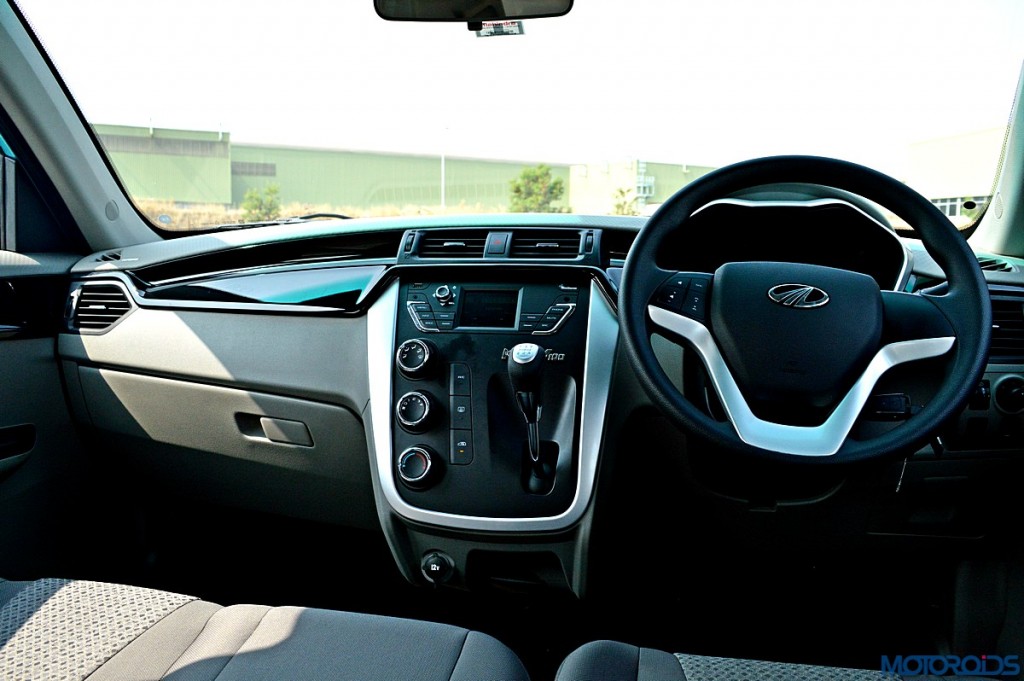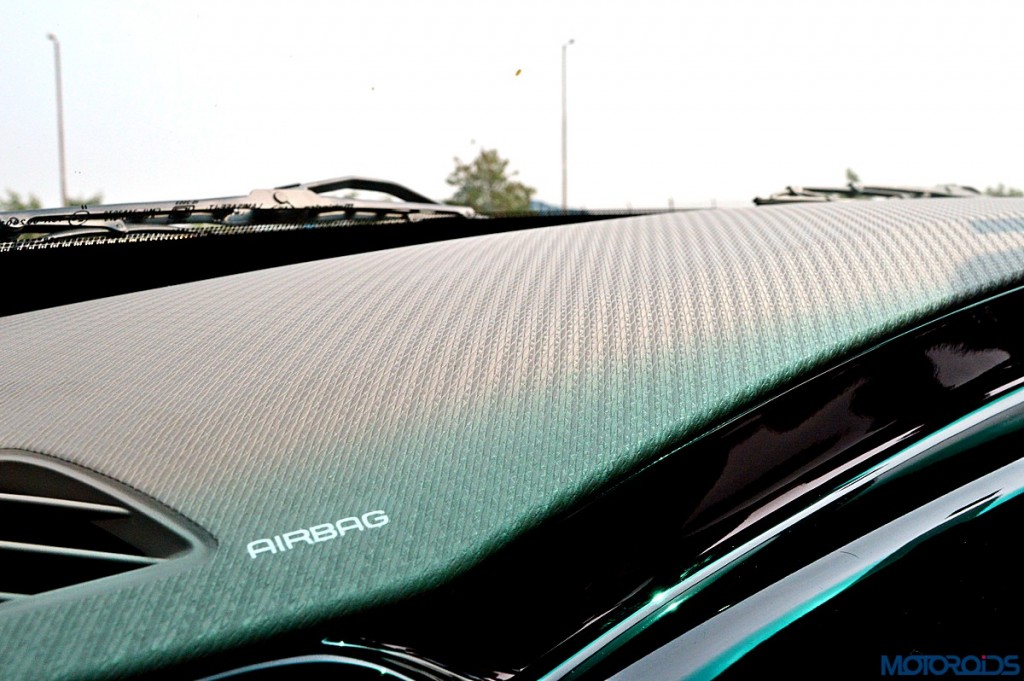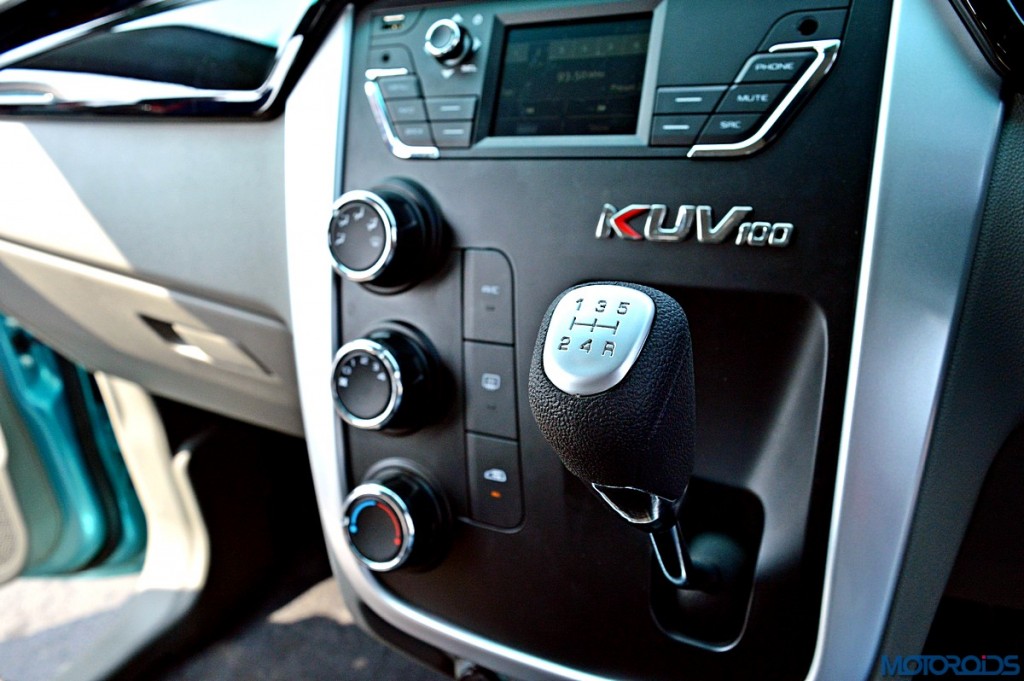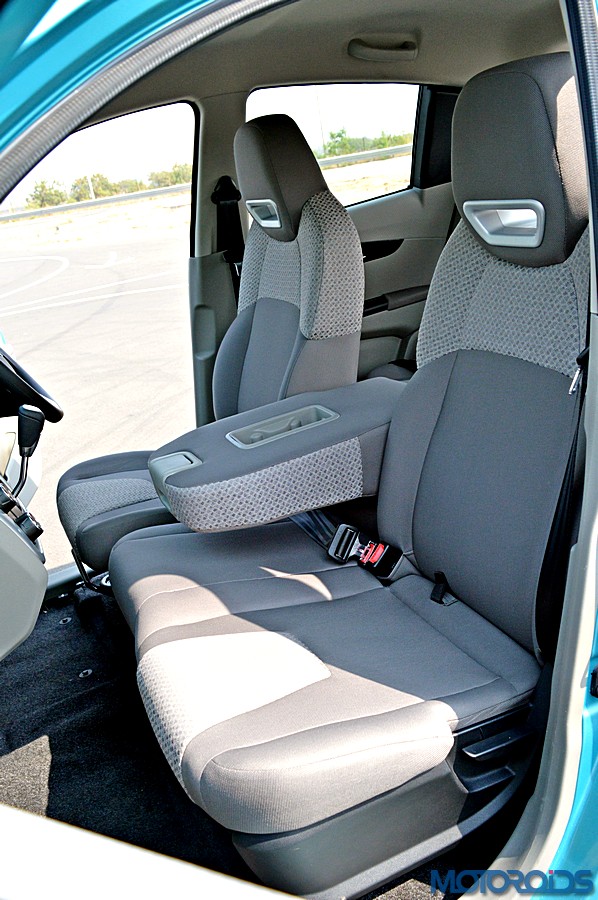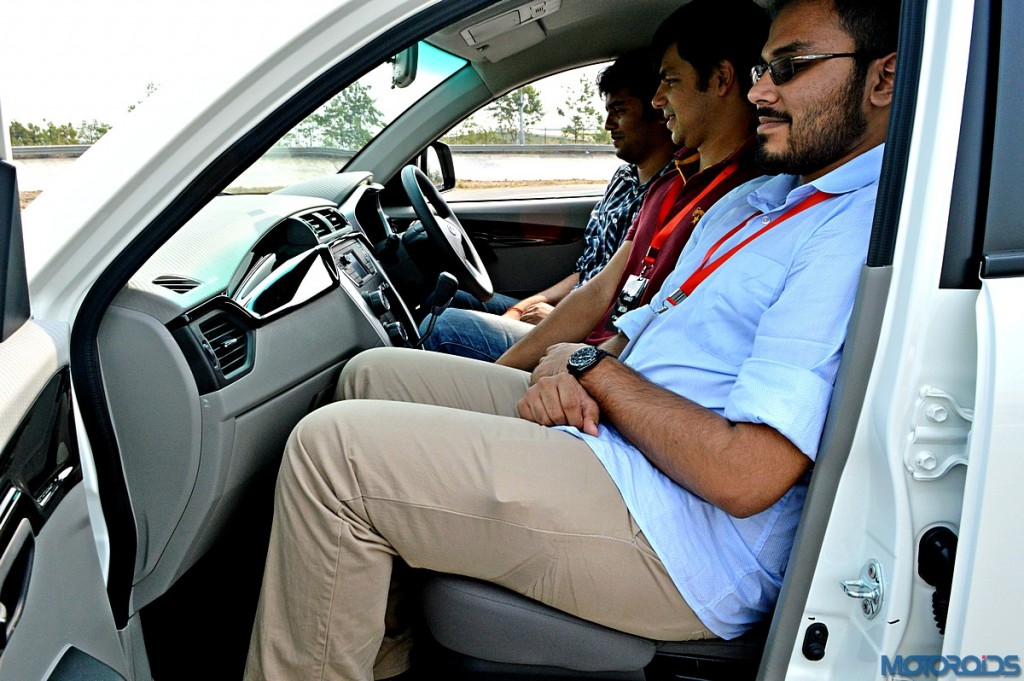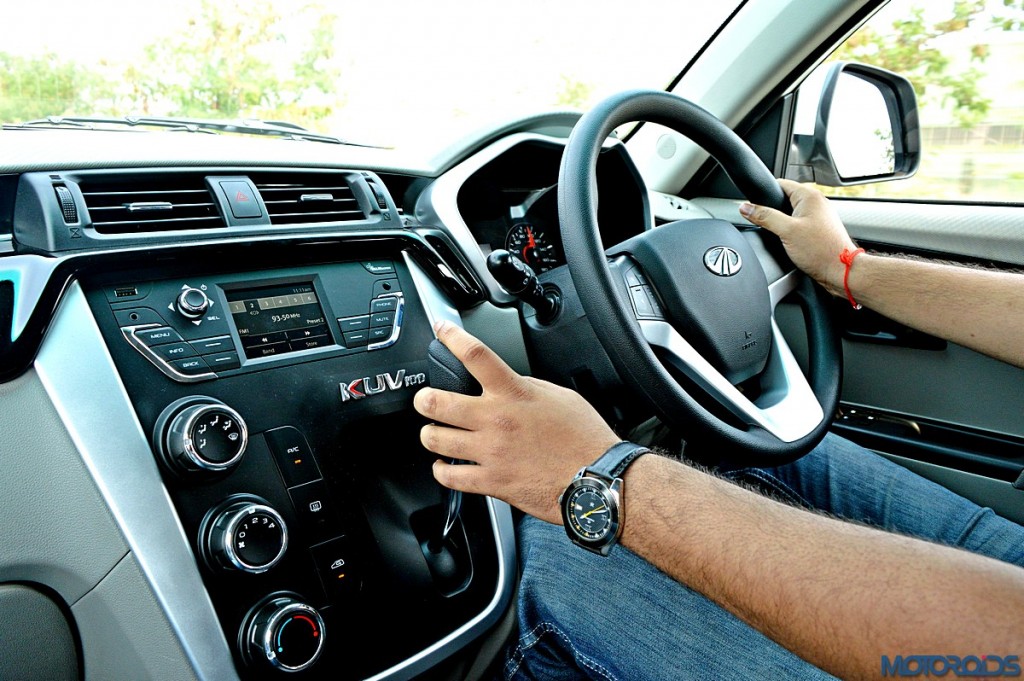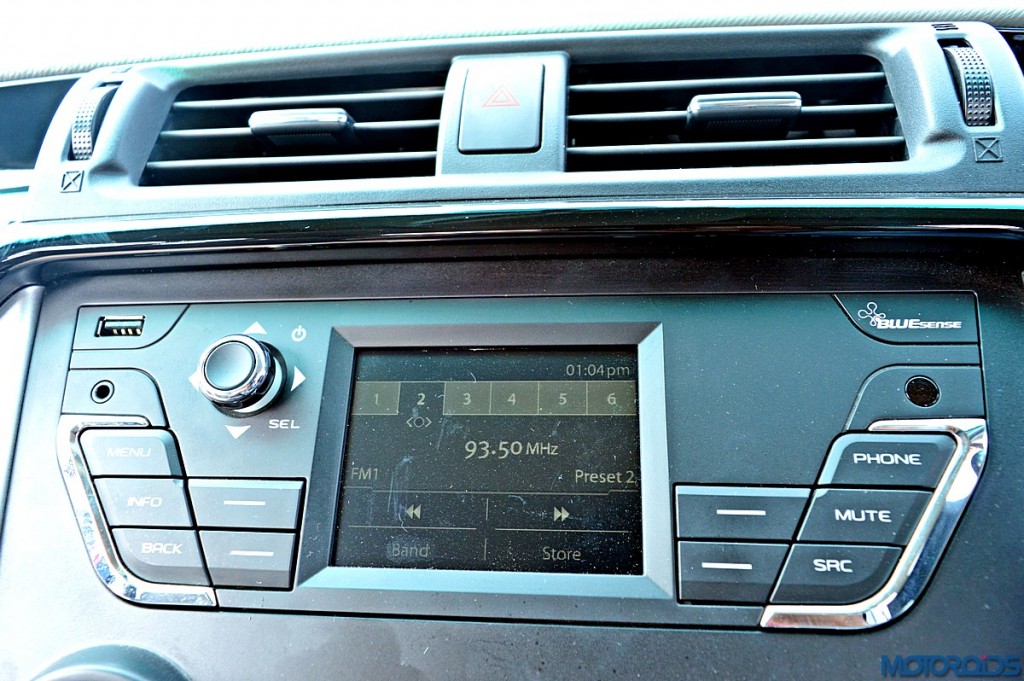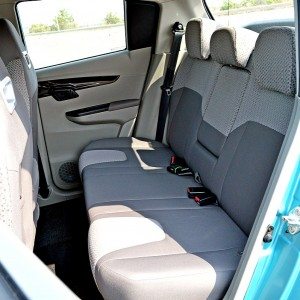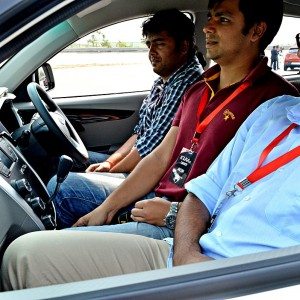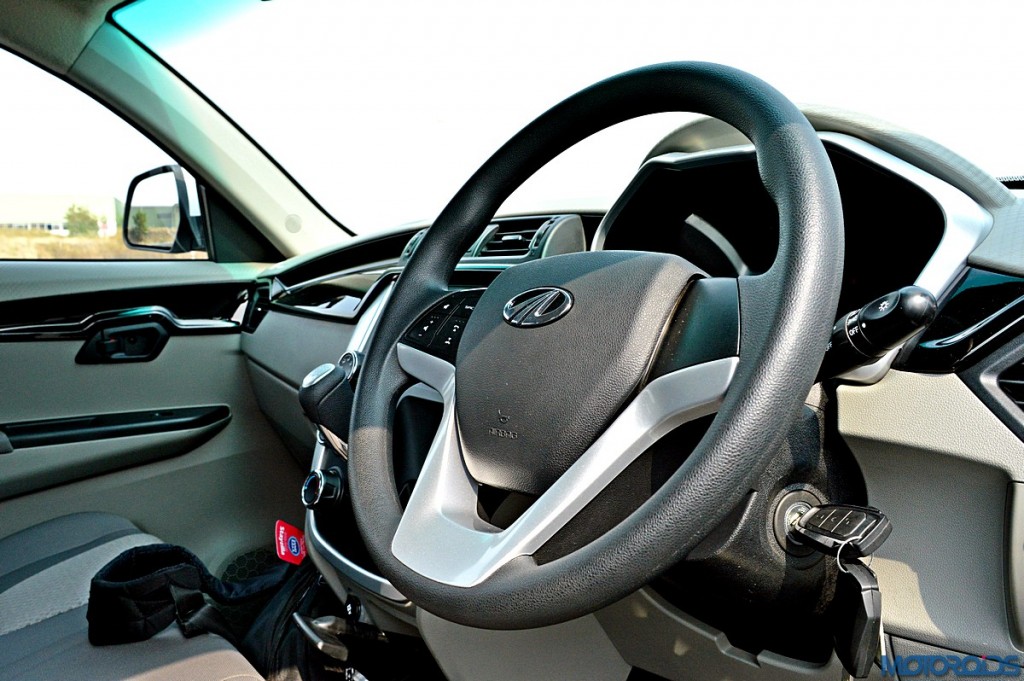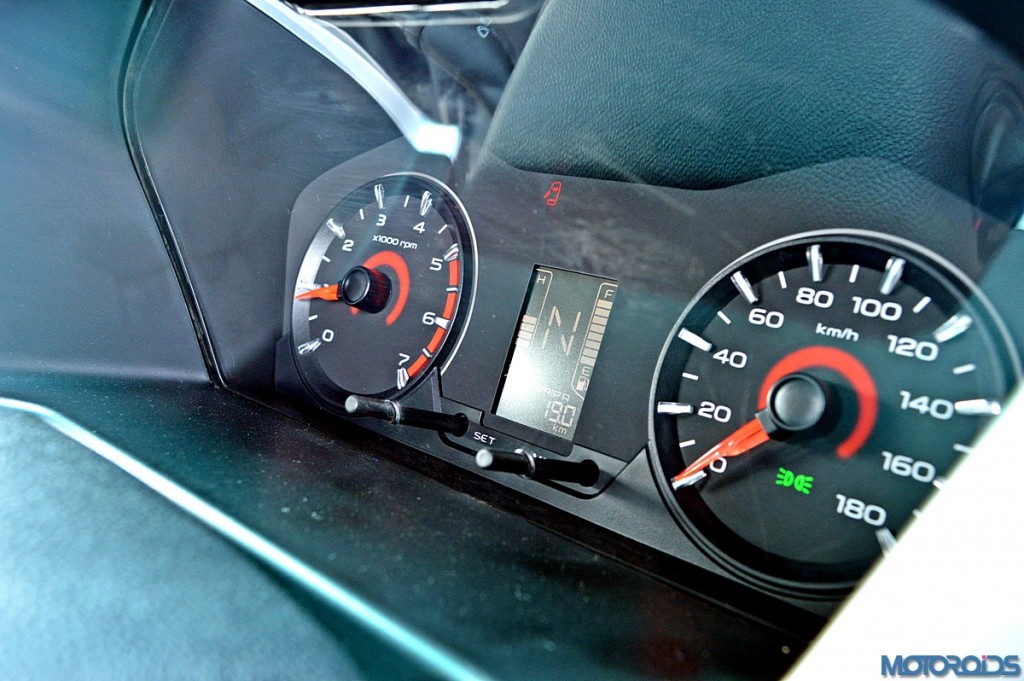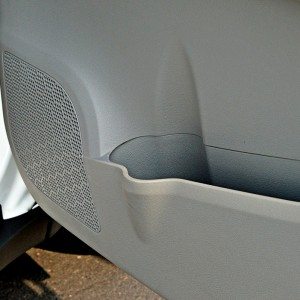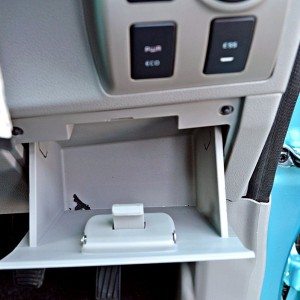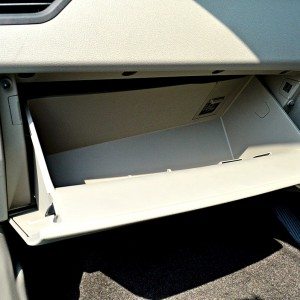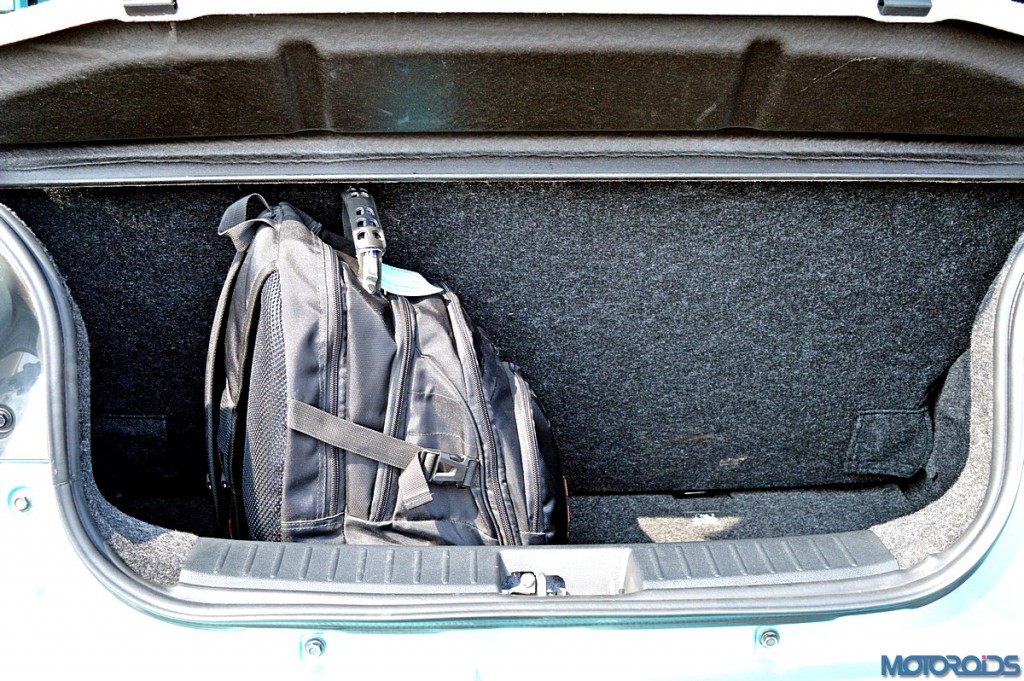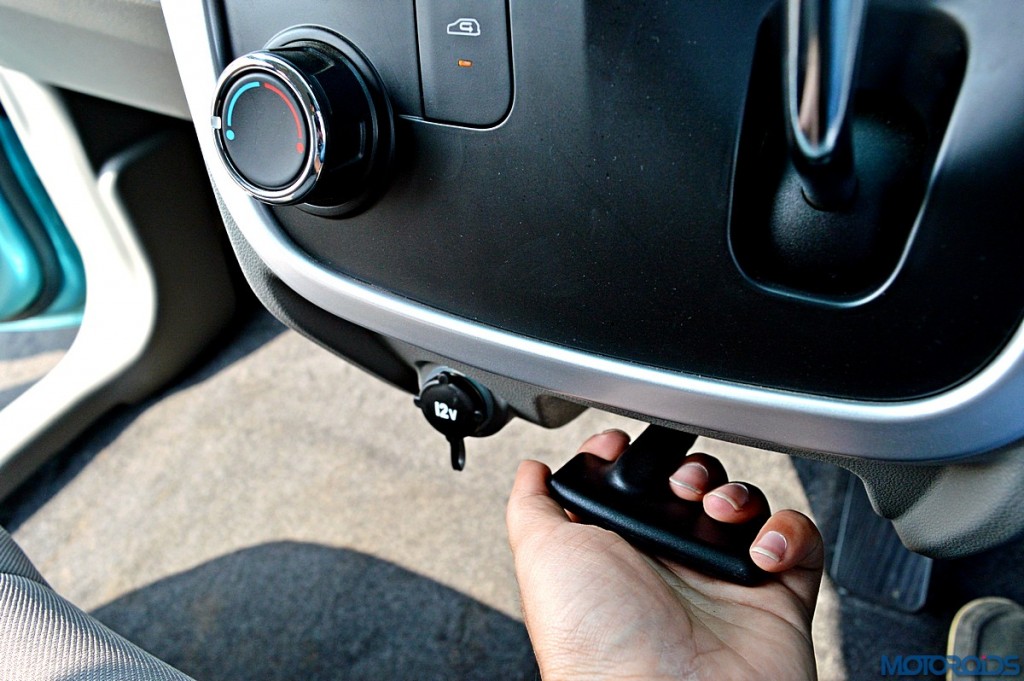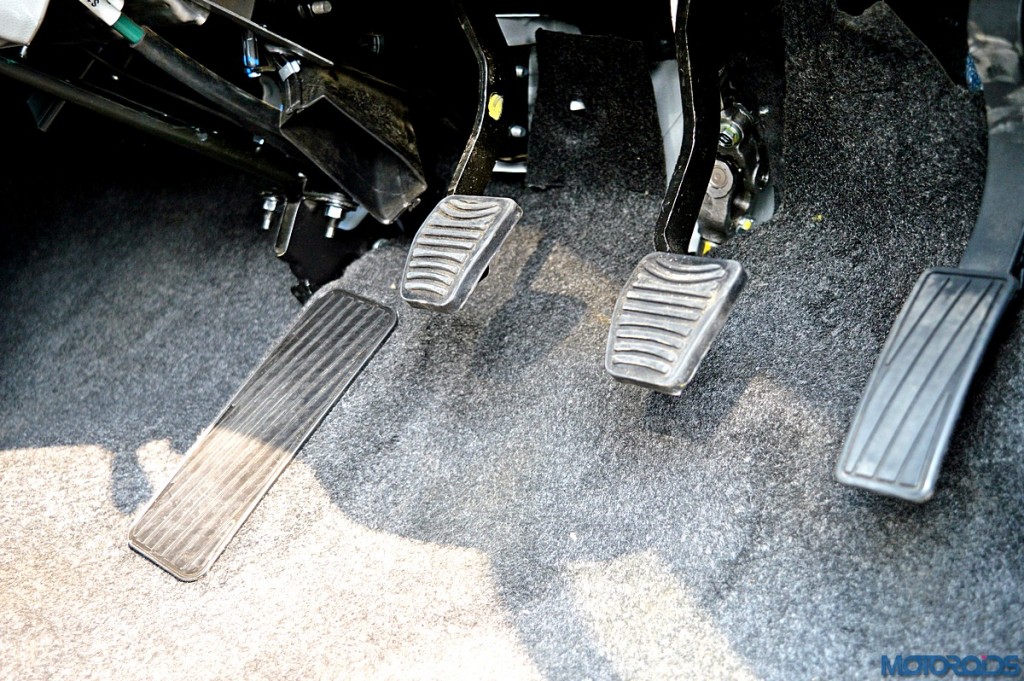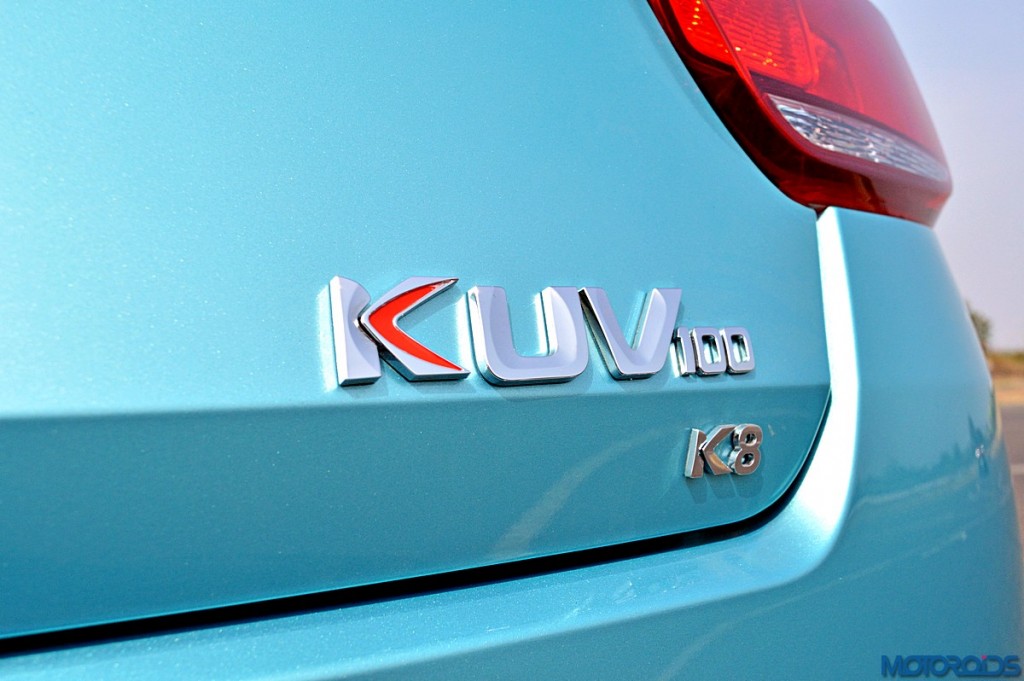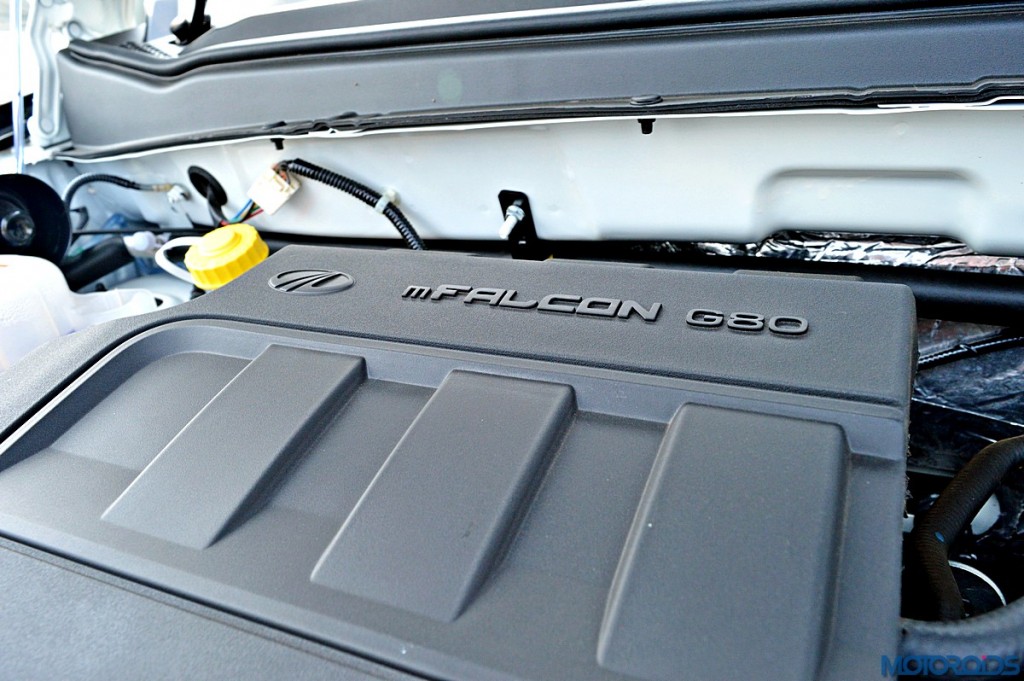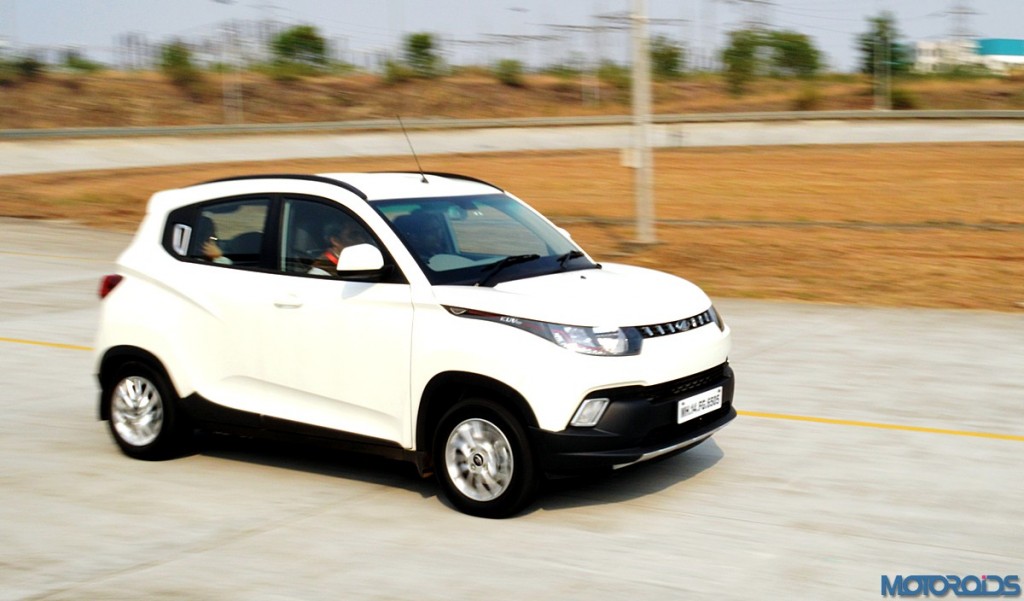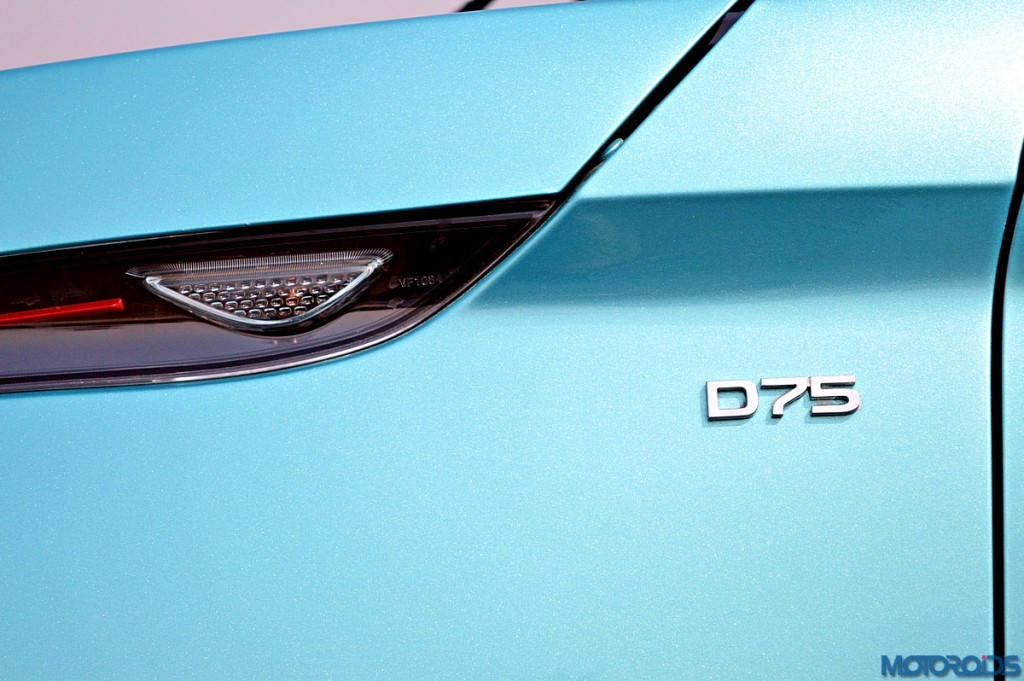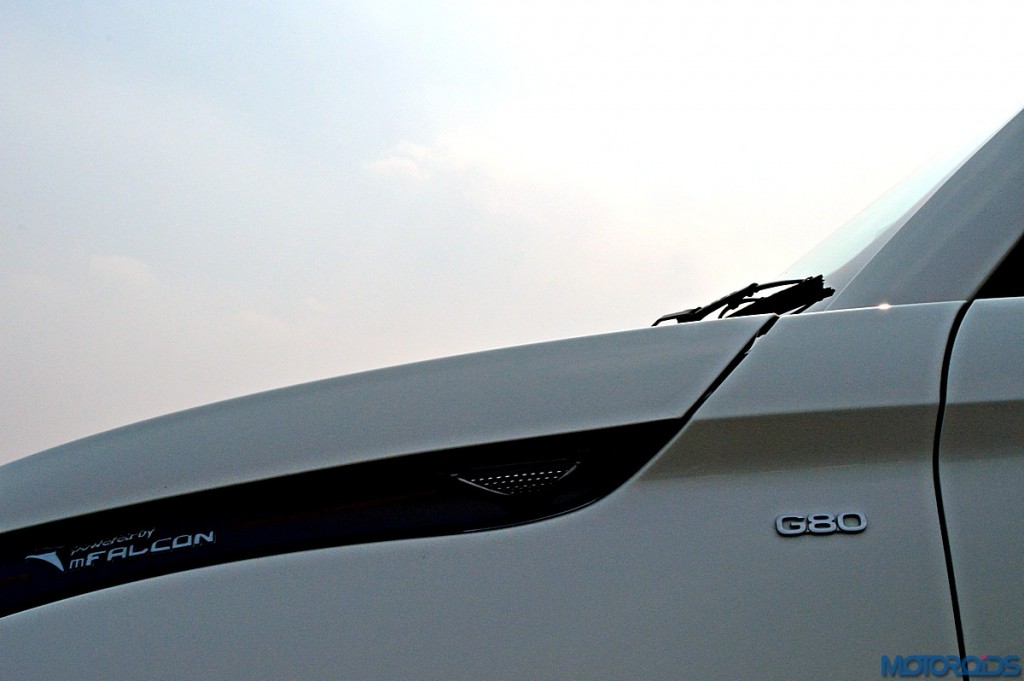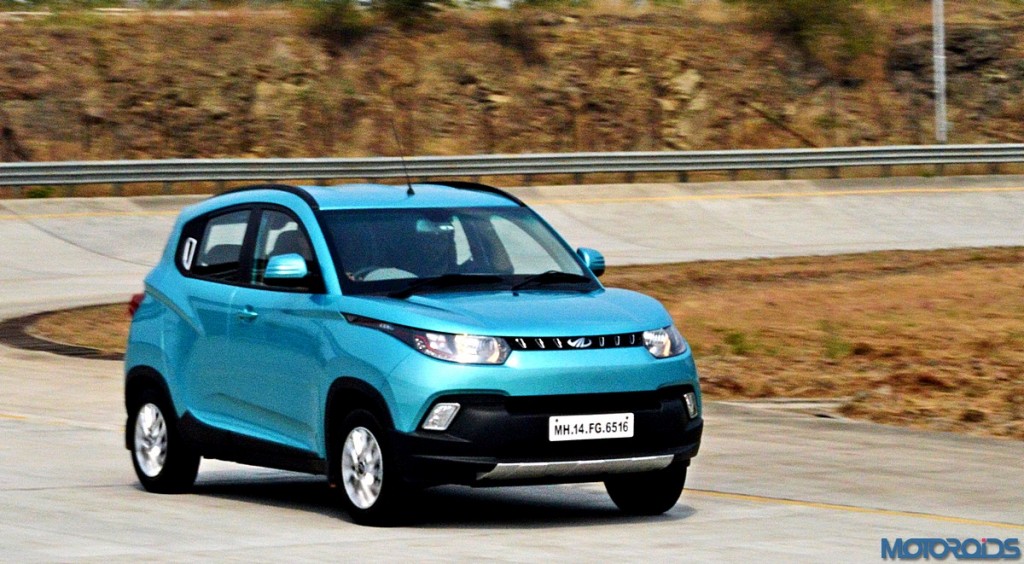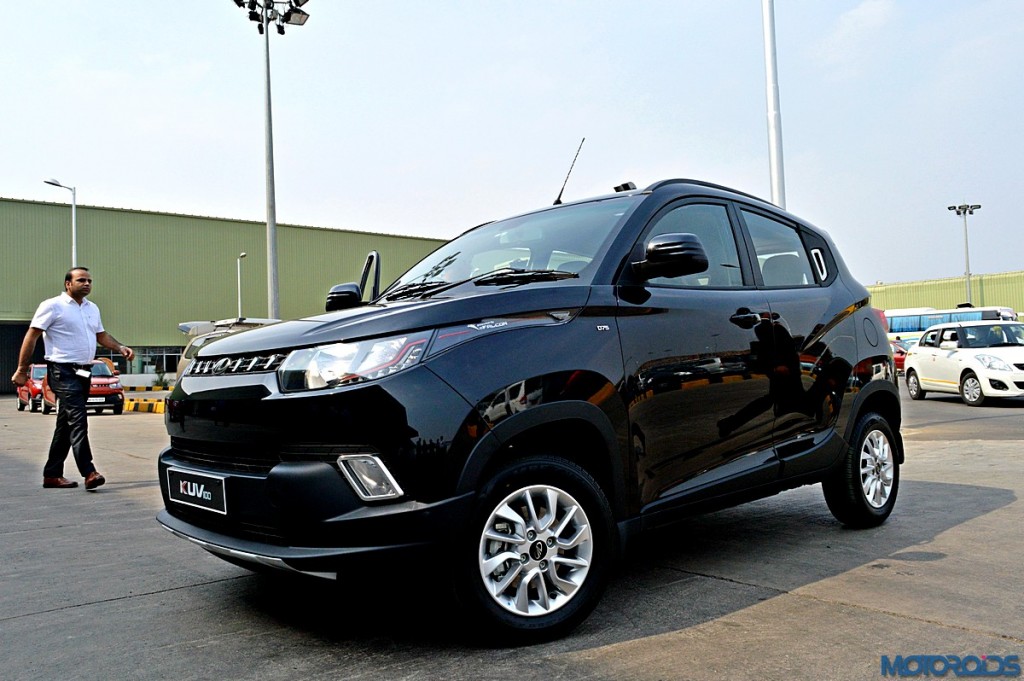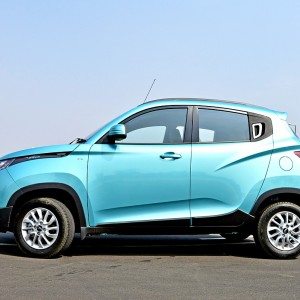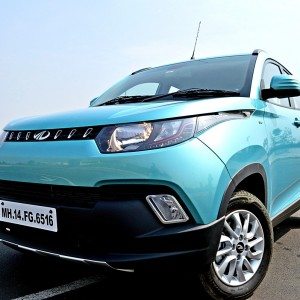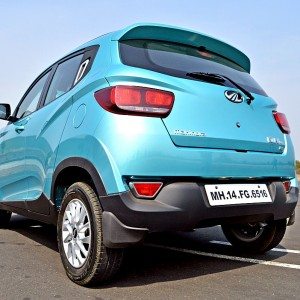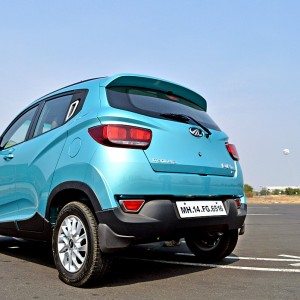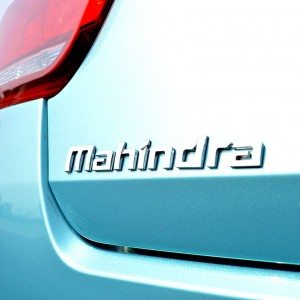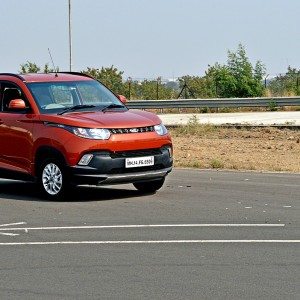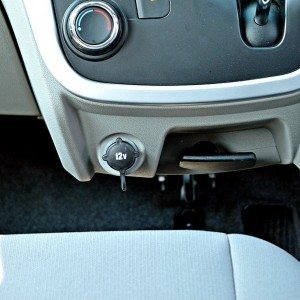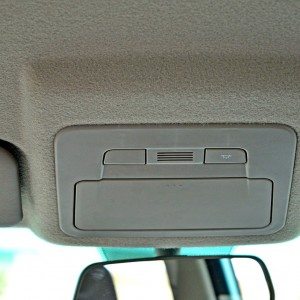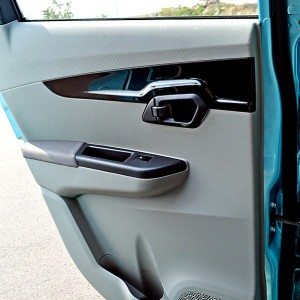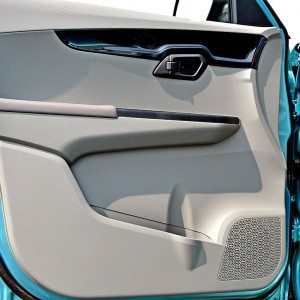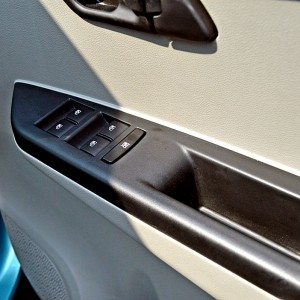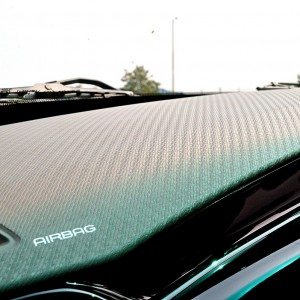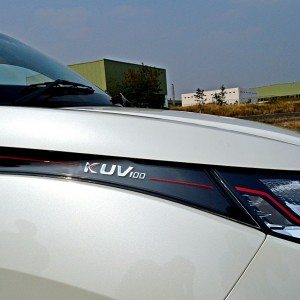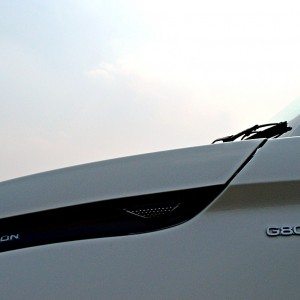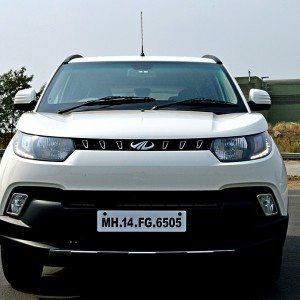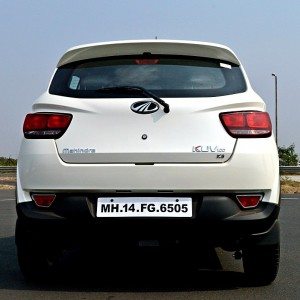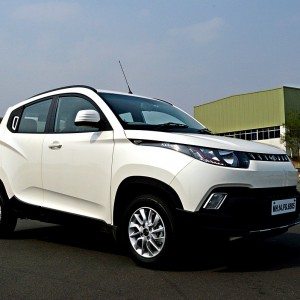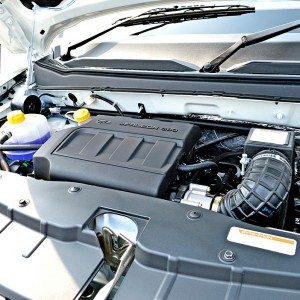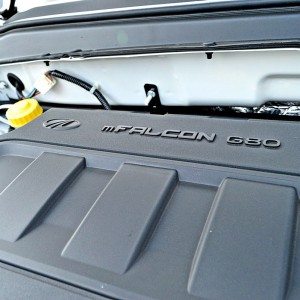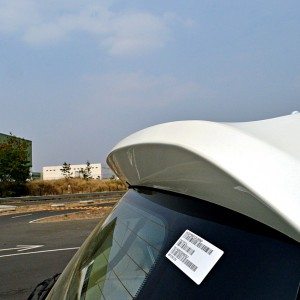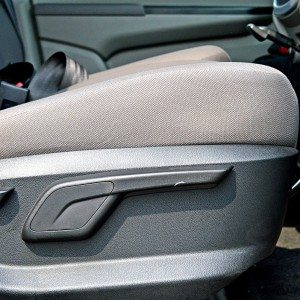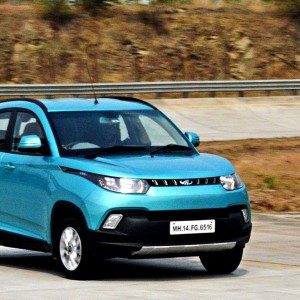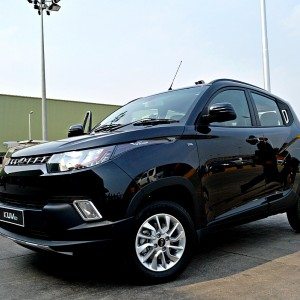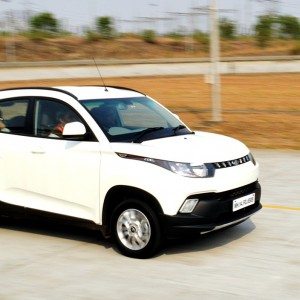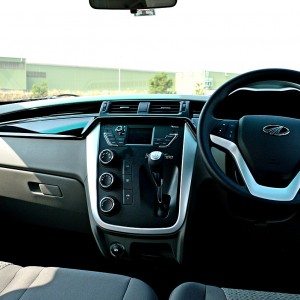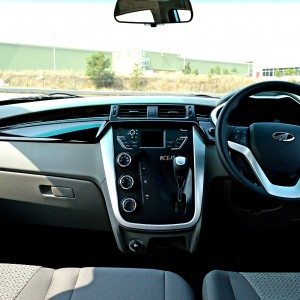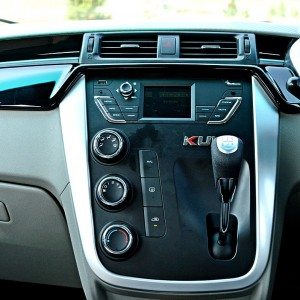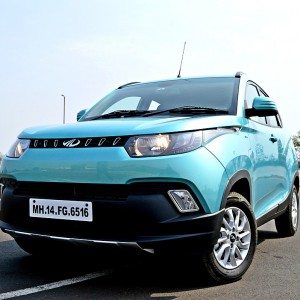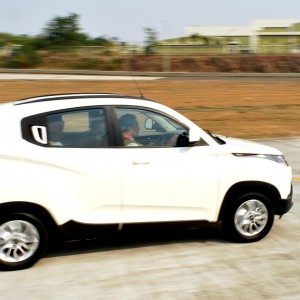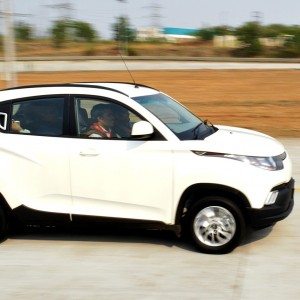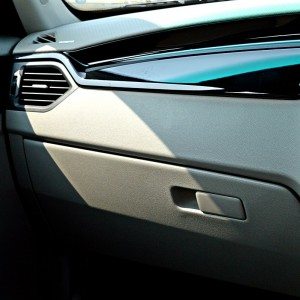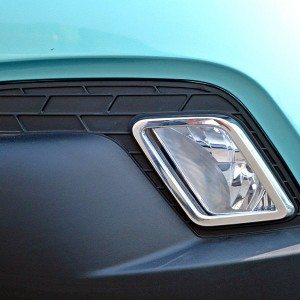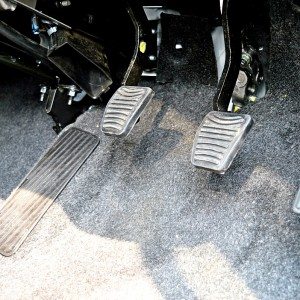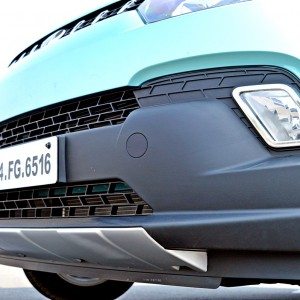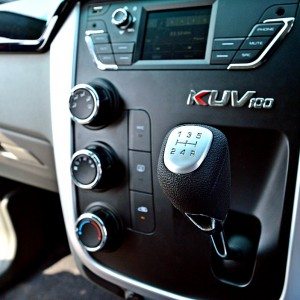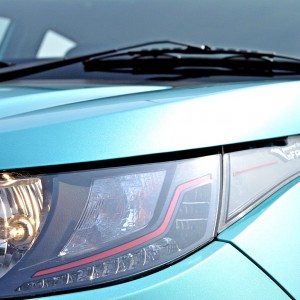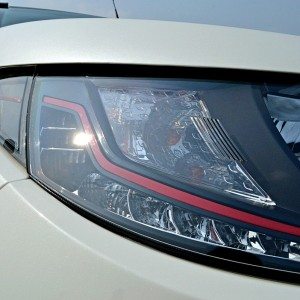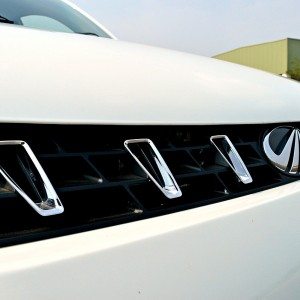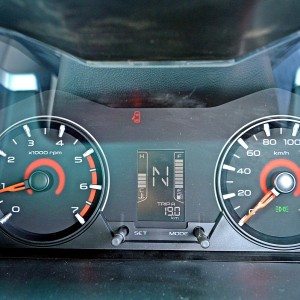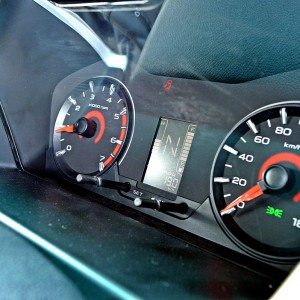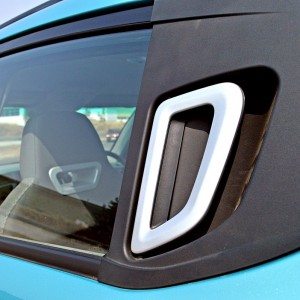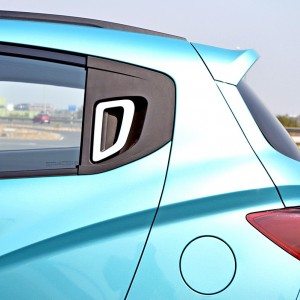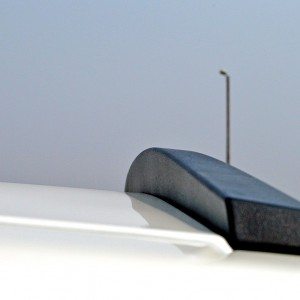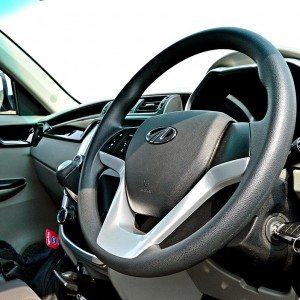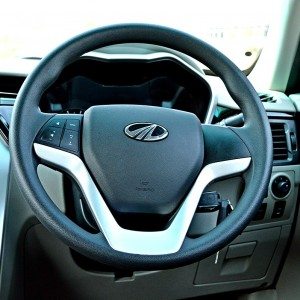Well, Mahindra’s looking at greener pastures to rear its new herd, which starts with the brand new KUV100. Pegged as a ‘young SUV’, the KUV100 is Mahindra’s first crack as the passenger vehicle segment, specifically in the fiercely competitive premium hatchback arena. Developed at a cost of INR 1200 Crores, and involving a brand new monocoque platform, along with fresh engines, the KUV100 is the Indian manufacturer’s most important launch in recent years. No wonder they’re calling it the second point of inflection for the brand after the Scorpio.
The sub-4 meter long KUV100 is primarily targeted at premium hatchback owners who’re relatively young and aspire to own an SUV. So Mahindra went ahead and built them one. Except it isn’t an SUV. Largely analogous to the Renualt Kwid’s styling theme, which blends hatchback frugality with shreds of utility vehicle machismo, the KUV100 is a hatchback in SUV clothing.
We got a chance to briefly sample the recently launched KUV100 at Mahindra’s manufacturing plant in Chakan, so here are our first drive impressions.
Styling
With Pininfarina on board, things are bound to get interesting. As far as appearances go, the KUV100 is like a warm sea breeze that gently thaws the frigidity of mainstream hatchback country. The proportions are well balanced, even though the puny wheels call out in alarm, while the somewhat quirky sculpting all around is oddly pleasing.
Pseudo toughness infusion comes in the form of scuff plates, body cladding and roof rails. There’s even an Explorer package which makes the KUV100’s character cash outdoorsy cheques its mechanicals can’t cash. Let’s get you a detailed insight on the KUV100’s stle through these images.
Amusingly, the headlamps are said to be inspired from sunglasses, which suddenly make sense when you look at the blacked out trails they’ve gorged on the sides.
Vaguely representing the arms of sunglasses, these elements emanating from the headlamps bear mFalcon branding (which represents the new family of engines) on the LHS and KUV100 branding on the RHS.
The headlamps themselves feature L-shaped LED signatures (which look pretty cool) and blacked out nacelles. The red pin striping is a neat touch.
The headlamps are bridged by the slimmest grille ever offered on a Mahindra vehicle, completing the Ray Ban effect. It retains the brand’s toothy signature though, highlighted by brushed silver accents.
The large front bumper is nicely detailed and gets a two tone treatment; with a body coloured upper half and a blacked out lower section that also hosts a scuff plate finished in dull silver.
The “dynamic” fog lamps are little, skewed rectangles that feature chrome trimmed borders.
The undulations on the mirror caps actually represent “pumping fists”
The sides feature bold sculpting that do a good job of disguising the KUV100’s tall stance.
The KUV100 gets high mounted rear door handles a-la Chevrolet Beat; top-level trims get dull silver trimmed surrounds for them.
The wheel arches are mildly squared off, and their flares climb high into the bodywork, giving some muscle to the sides. Black cladding runs all along, but is nicely integrated.
The distinctive, strong rear haunch creates an arch over the rear wheel arch flare and extending into the tail gate, shadowing the double-barrelled tail lamps.
The tail lamps rise and shine from the bodywork, giving them a strong 3D-effect feel.
The flush fitting rear bumper has been effectively designed to keep overall vehicle length less than 4 meters. The bumper also features a black plastic trim running across, which hosts the registration plate recess flanked by chrome bordered, trapezoidal dual fog lamps – a first in class feature.
Other highlights on the posterior include a rear wash/wipe function and an integrated spoiler.
The top-end K8 trim level of the KUV100 will be shod with 185/65R14 tubeless footwear with 12-spoke alloy wheels.
Dimension wise, the KUV100 measures 3675 mm in length, 1715 mm wide and 1655 mm high, along with a wheelbase of 2385 mm, rendering it slightly bigger than competition. Also, the 170 mm ground clearance is class leading.
Interior
The KUV100’s interiors are a nice place to be in. It’s quite spacious and airy, given the slightly larger volume it displaces as compared to its hatchback brethren. The dashboard design is quite contemporary, while the ambience is set by acres of piano black trim contrasted with a light beige colour scheme. Dull silver and matte black inserts juxtaposed with each other add to the palette.
The top of the dashboard is finished with a textured, soft touch surface that ups the premium quotient.
The highlight of the dashboard is be the centre console mounted gear lever which has been accommodated there to make way for the middle occupant of the first row.
The KUV100’s front passenger seat features an extension that allows for a third occupant to settle in between the passenger and the driver – a la Datsun GO and GO+. The arm-rest doubles up as the central occupant’s backrest not used as one. This unique 3+3 seating makes the KUV100 the only vehicle in its segment to offer 6 seats.
Mahindra emphasizes that the middle seat in the front is for occasional usage only, and as we found out, things get too close for comfort if three relatively large adults share the same space. At best, the middle section is reserved for a child, or your girlfriend. There’s a lap belt in the middle for some semblance of safety, but in the event of a frontal impact, the middle occupant is done for. In case you’re not up for it, Mahindra also offers a more conventional 2+3 seating layout, with a regular front passenger seat.
As for the position of the gear lever from an ergonomically viable viewpoint, it works just fine once gotten used to. The HVAC control knobs are vertically stacked to make way for the gear lever.
The integrated infotainment system with a 3.5-inch display is compatible with Mahindra’s new BLUESENSE app, via which one can control features of the infotainment system as well as see information related to climate control, TPMS (Tyre Pressure Monitoring System), fuel statistics, etc. However, there is no touch-screen feature here. Sound quality from the 6 speakers is good, but not a patch on, say, the Tata Zica’s 8-speaker job.
The seats themselves are nicely bolstered and supportive and we couldn’t find a fault to them during our brief test drive. Space at the back is also quite generous, although the rising window line is a bit too high set. The lack of a quarter glass at the back is a bit irksome, as it has been sacrificed for the high mounted door handle.
The new, multifunction, tilt adjustable steering wheel hosts the audio and telephony controls, while overlooking the conventional, analogue instrument cluster with a central MID.
Compared to the rest of the design, the instrumentation lacks pizzazz.
In terms of storage, the KUV100 offers a 1-litre bottle holder on each door, a reasonably spacious glove box, cup holders on the arm rests, a large storage bay concealed under the front passenger seat and one even hidden in the floor at the back.
The 243-litre boot is useable and can be enlarged to 473 litres by folding the rear seat backrest down.
The handbrake lever comes with a push-pull mechanism that takes some time getting used to.
The dead pedal is a bit oddly positioned, but does the job.
The Mahindra KUV is available in a total of 7 trim levels for both petrol and diesel powered variants. The fully loaded K8 variant features dual airbags, ABS with EBD, alloy wheels, foglights (front and rear), Micro-Hybrid Start/stop, Power-ECO mode (diesel), steering mounted controls, height adjustable driver seat, daytime running lights, power windows all doors, central locking with remote, a 6-speaker infotainment system with Bluetooth, cooled glove box, follow-me-home lamps, lead-me-to-vehicle lamps, rear defogger, puddle lamps, day-night internal rear view mirror as standard. Build quality is the best for a Mahindra vehicle we’ve witnessed so far.
Engines
The KUV100 is powered by two, all-new engines that usher in the mFalcon family. The fresh family of engines, developed in conjuction with SsangYong, will comprise power plants with a cubic capacity of 1.2, 1.5 and 1.6 litres. With fuel types including both petrol and diesel, the new engines will be available in a total of six variations. Apart from diesel engines, an area where Mahindra has a significant amount of expertise, the mFalcon family will also comprise some ground-up petrol engines.
The new mFalcon engines have amde their debut on the KUV100. Mahindra is terming the mFalcon engine used for the petrol version as the mFALCON G80, and the diesel version as the mFalcon, D75.
Note: These are initial impressions, as we drove both the diesel and petrol versions for not more than a couple of laps each at Mahindra’s test facilities at their Chakan plant near Pune. We’ll be putting together a full road test review soon, where more light will be shed on the character of the two engines and the dynamics of the vehicle. So stay tuned.
Diesel power for the KUV100 comes from an all-new, indigenously developed, 1.2-litre, turbo-charged engine that features a cast iron block and aluminum head. It’s good for 76.4 bhp at 3,750rpm and a notable 190 Nm between 1,750-2,250rpm.
The diesel engine, dubbed the mFalcon D75, felt quite refined, with a muted clatter at idle. On the go, it clearly has that step in performance post 1,900 rpm, when the turbo starts to spool. One wouldn’t also call it exactly lethargic below the aforementioned engine speeds either, as there’s decent poke that’s perfectly suited to low geared, urban usage.
When the road opens up, the diesel engine pulls decently once it is in the power-band, which is effectively upwards of 2,000 rpm. Momentum runs out of steam before 4,500 rpm, post which the motor doesn’t like encouragement. However, it manages to reach three digit speeds without too much poking, and holds its own when it arrives there.
Although we didn’t get a chance to stretch its legs, we believe that drivability in town should be good in spite of the slight turbo-lag. In fact, cruising abilities should be decent too. Most of it can be attributed to the healthy torque rating that kicks in thick and early. The D75 motor also offers two drive modes – Power and Economy. The latter mode sucks power; sloths throttle response, and never let the engine speeds go beyond 3,600 rpm, which makes it quite bit dull to drive in.
Well, in Power, which is the default mode, don’t expect to go anywhere near the claimed 25.32 km/l fuel efficiency figures. Still, it’s being touted as India’s most frugal SUV, so we reckon it’ll be quite easy on the pocket in the real world too. As far as first impressions go, the KUV100’s diesel engine ticks all the right boxes.
Clutch action is light, but the biting point comes really early, so it needs constant modulation. Special props go to the transmission, which is surprisingly slick and effortless to row. Overall refinement levels are acceptable for its segment too, with not much engine noise filtering inside.
The petrol engine is all-new as well, and derives from SssangYong’s 1.6-litre, four-cylinder unit that already does duty in the Tivoli compact SUV. All of 3 cylinders and displacing 1.2 litres, the mFalcon G80 has an all-aluminium construction and features dual variable valve timing. On paper, the engine produces a healthy 82 bhp at 5,500rpm and 115 Nm from 3,500-3,600rpm. In the real world however, those numbers don’t really translate.
Although we are yet to test it on public roads, our brief stint on the track left us asking for more from the engine. Sure, it smooth and adequately refined, but to make decent progress, one has to always keep it on the boil. It revs cleanly because of natural aspiration, but not freely. Redline comes in at 6,000 rpm, but by then it’s already struggling to shift *unspecified* kilograms of KUV100. There is some enthusiasm in the upper reaches of the rev band, which tapers off way below the redline.
With four adults on board, the KUV100 petrol hit the ton mark with some amount of asphyxiation. With 6 people on board, we reckon it’ll be a bit suffocated to perform. The engine does, however make a muffled exhaust note that’s fairly pleasant to the ears. Just the right amounts of notes enter the cabin too.
We can’t vouch for the drivability of the mFalcon 80 engine in real life conditions, though we reckon that it’ll get the job done, but only just. However, we’d pick the diesel engine, and even say that its competitors have a slight edge over the KUV100 in this department. Courtesy of a Start Stop system, Mahindra claims an optimistic fuel efficiency figure of 18.15 km/l, and we believe that’s the only USP of the KUV100’s petrol engine.
Ride & Handling
Suspension wise, the KUV100 runs on a conventional McPheron setup at the front and a semi-independent twist beam setup at the back. Ride quality of the baby Mahindra is familiarly cushy, considering the setup, like on the Scorpio/Xylo, is tuned to on be softer side. Though comfortable at all speeds, the KUV100 pitches and bobs, especially under hard braking, during aggressive gear shifts and going over undulations at high speed.
The electronic power steering is an enthusiasts’ nightmare, as its feedback can be put somewhere between very little to almost none. It’s lightness should be a boon in city traffic, but as speeds rise and the going gets twisty, there’s just information of what the front wheels are up to. That, coupled with the soft suspension induced body roll, makes the KUV100 a handful on roads that are a drivers’ delight.
Hard braking causes a fair amount of front end drive, but the KUV100 managed to hold its line, albeit with a bit of squirming. ABS, which comes as standard across all variants, helps its cause. Brake bite and pedal progression felt good. Straight line stability left no causes for concern either, with the KUV100 sitting rock steady at triple digit speeds.
From our brief test run, it was hard to differentiate between the petrol and diesel powered versions of the vehicle, as far as driving dynamics go. The full road test review, due soon, should attest to that.
Verdict
The new Mahindra KUV100 is an intelligently developed, capable product that shows the Indian’s conglomerate’s coming of age in the automotive sector. Its quirky, SUV-like looks are oddly appealing, and have trappings to create a stir in the minds of a section of the youth who’d otherwise have continued driving their mundane hatchbacks. The interior is well laid out, spacious, and has its fair share of quirks as well, including the 3+3 seating layout that’ll come in handy when the situation arises. The cushy ride quality will appease its intended audience, while the diesel engine should strike the right balance between good drivability and frugality in the real world. What’s more, its adequately refined too. The petrol engine is a bit of a downer though, and so are the enthusiastic driving dynamics. But the latter has been purposely engineered in to be it a mass pleaser, which is quite understandable.
As for features, the KUV100 comes loaded to the brim, apart from a touch screen equipped infotainment system. Then there’s the price, which start at INR 4.42 lakh for the base petrol variant and INR 5.22 lakh for the base diesel variant (ex-showroom Pune). Even the top-end diesel variant with all the bells and whistles stays below INR 7 lakh. Overall, the new KUV100 should have already sent shockwaves across hatchback camps, as it has what it takes to be a winner. We’d conclude by saying that though it doesn’t even offer something remotely special for the keener driver, it’s a trendy package that induces bucket-loads of want from its intended audience.

